REIMAGINING THE CANVAS
De la Cruz refers to the grandiosity of painting.
On the Lisson Gallery website I read: “The moment I cut through the canvas I get rid of the grandiosity of painting”, she says. ( https://www.lissongallery.com/artists/angela-de-la-cruz)
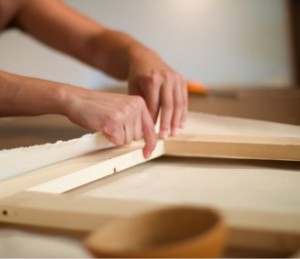
On the Tate website, I found the following description for plane/picture plane: A picture plane refers to the physical surface of the painting.
In traditional illusionistic painting using perspective, the picture plane can be thought of as the glass of the notional window through which the viewer looks into the representation of reality that lies beyond. In practice the picture plane is the same as the actual physical surface of the painting.
In modern art the picture plane became a major issue. Formalist theory asserts that a painting is a flat object and that in the interests of truth it should not pretend to be other than flat. In other words, there should be no illusion of three dimensions and so all the elements of the painting should be located on the picture plane.
Exercise 1. Stretch, stitch, fold, crease, warp
I understand for the first exercise I need to revisit ideas around the basic anatomy of the stretcher, question it and or explore painting with or without it. Does this mean I need to look at manipulating the canvas – stretch, stretch, fold, crease, warp?
What type of support or surface does painting ask? Is it asking me to raise questions regarding pre-existing assumptions? Does it threaten or challenge definitions of painting?
it is a known fact that humans have been expressing themselves for at least 100 000 years. I have seen a copy of a stingray (Fig. 3) created out of the sand, the archaeologists estimate it is at least 150 000 years old, (jewelry was also found in this area) and believed to be the oldest fossiled footprint, called the footprint of Eve (Fig. 2) I believe a footprint is a sign of impermanence, and in this case a clue to humanity and its development. The paleolithic cave paintings and how they are dated is giving us a better understanding of human creativity and thinking (storytelling/representation). The cave wall was the support/canvas. Seems we then moved to walls and then to boards…then to canvas? To prime the surface came with this development, as one’s concerns are mainly how the paint/ink will be absorbed by the surface, how it will dry, and last. It does make me think of the sharp etching tool that was needed to draw the stingray in Fig. 3
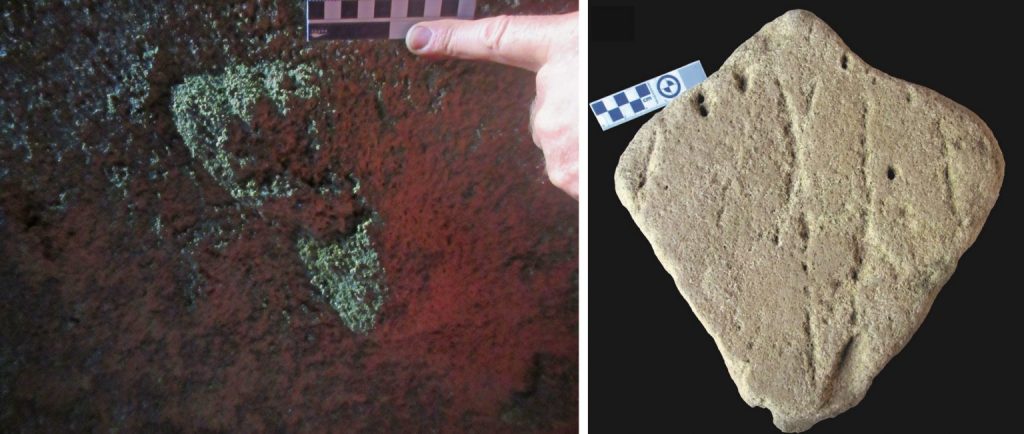
I think when I ask somebody to describe a painting, their description would be within the parameters of being on a canvas or board support, and possibly framed to hang. Did art history not take archival-quality too far?
Below are images of the French Support Group I found during my research.
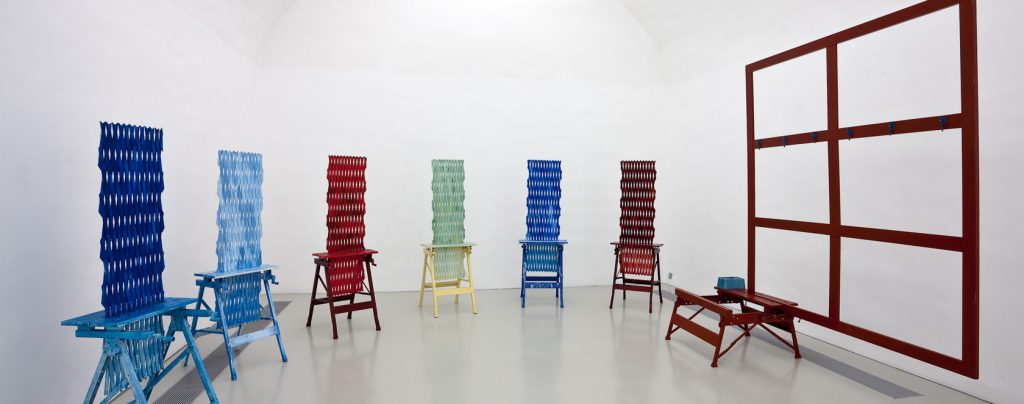
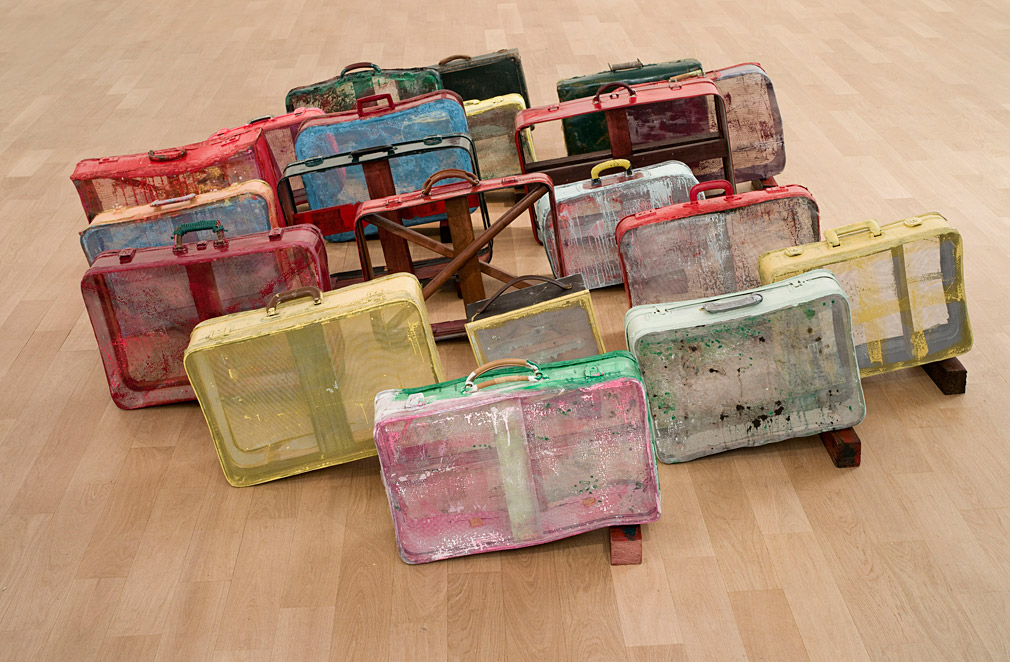
The French Surface/Support group of the 1960s were formed in the South of France. Apparently, this group of artists felt that painting has not come to terms with its most basic convention, materialism, a concern with medium, and the importance of the creative process, questioning pictorial idealism. They, therefore, deconstructed – showed what was hidden and individualized the different elements of the stretcher and always show the work as a product of human hands. The surface was addressed by some of the artists in this group and others worked with support. They also engaged in a sustained dialog with other contemporary intellectuals, writers, and poets.
What I found really interesting was the following: “Beyond their geographical differences, they all agreed on the fact that practice (painting) should go hand in hand with theory (writing, or critical thinking), but the southerners foregrounded practice where the Parisians emphasized theory and political activism. (Kerlodouw, 2014). I also learned that their work was placed outside in the town of Montpelier ( in order to later analyze the effects of the environment on the works presented). By placing it in the space of the public, no intentions of the work, who to attend a viewing and or ignore the action, was created. It does question the role of the artist and the viewer.
The study guide suggests I consider the following questions through practical investigation:
- If the canvas doesn’t just have to be a single piece of canvas pulled taught across a stretcher what can it be”
- Does the canvas have to be a fabric support or could other materials be used?
- Does the material have to be a plain fabric” What if you bagan with a patterned material?
- If the ‘canvas doesn’t have to be taught, can it be sagging or hanging?
- If the surface comprises of more than one surface how does this come together:
- are the surface pieced together as in a quilt, are they layered or wrapped around the stretcher?
- Could the stretcher become encased in a canvas packaging or could the canvas be woven or knitted onto the stretcher?
- Do you need to use a stretcher?
METHOD
Exploring what could a canvas be – looking and ‘making’ some ‘canvases’.
Considering if the canvas has to be fabric support or could other materials be used: I used the wooden blocks I covered with aluminum and a gypsum object from previous projects. I added acrylic medium, gesso, soft pastels, acrylic paint, and acrylic ink on the ‘canvases’ below.

Image The first attempt was line making with acrylic paint and then exploring a gesso line. I consider waiting till it dries and then exploring further.
The circular layer of acrylic medium and ink were used to make imprints on aluminum.
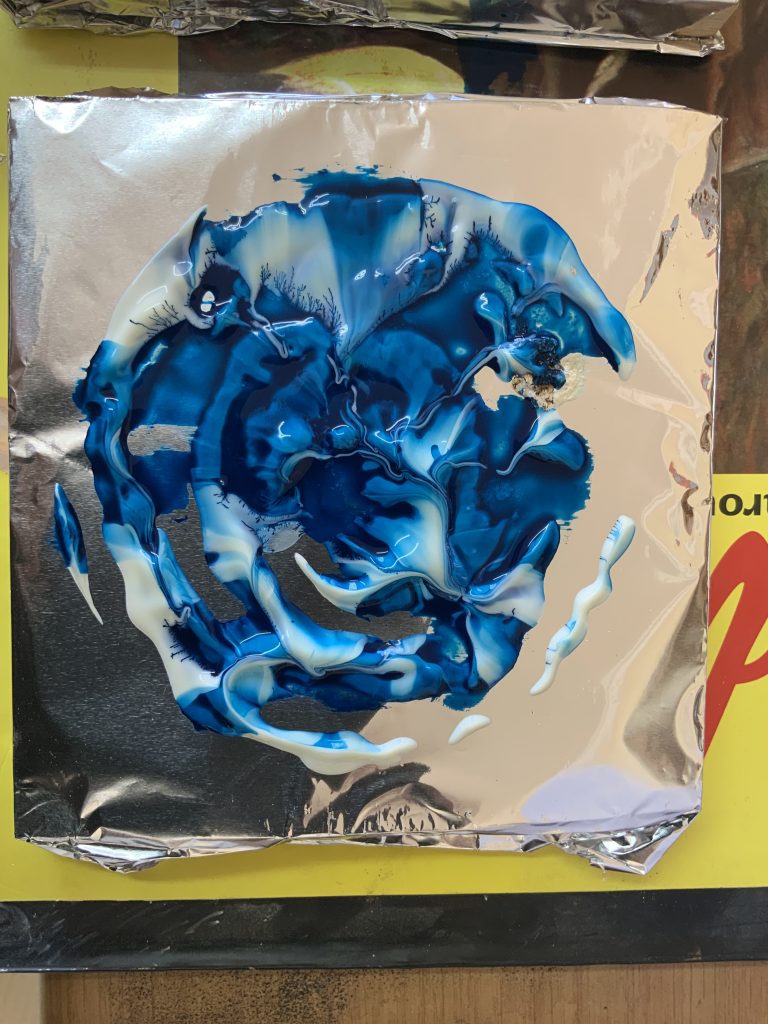
I used above to imprint onto ‘tracing’ paper and like the textures as it dried.
Using aluminum foil is working well – the paint adheres to the surface, and I can get opaque and translucent effects, by using gesso and acrylic gels. The texture of the medium makes it a fragile canvas, can tear and crease easily. It can attach to almost any structure if needed.
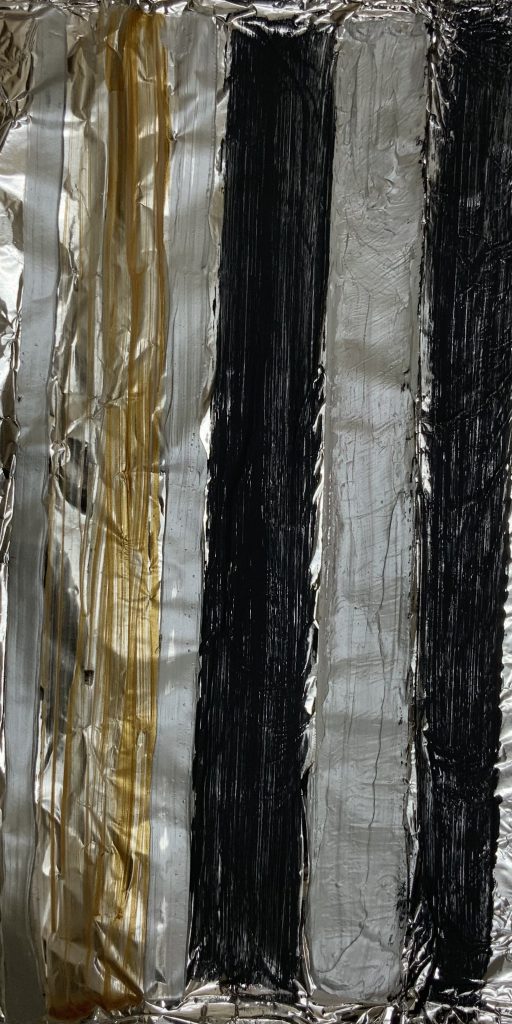
Textiles fascinate me and I would like to explore making around this. I have been using tea bags for small watercolor and ink drawings and have been considering to upscale the support. I can stitch them together. I tried to make small support using a leftover roll of plaster of Paris and sticks and wire as support. When it is dry, I can consider priming it. See images, Fig.11, Fig. 12, and Fig. 13 below.
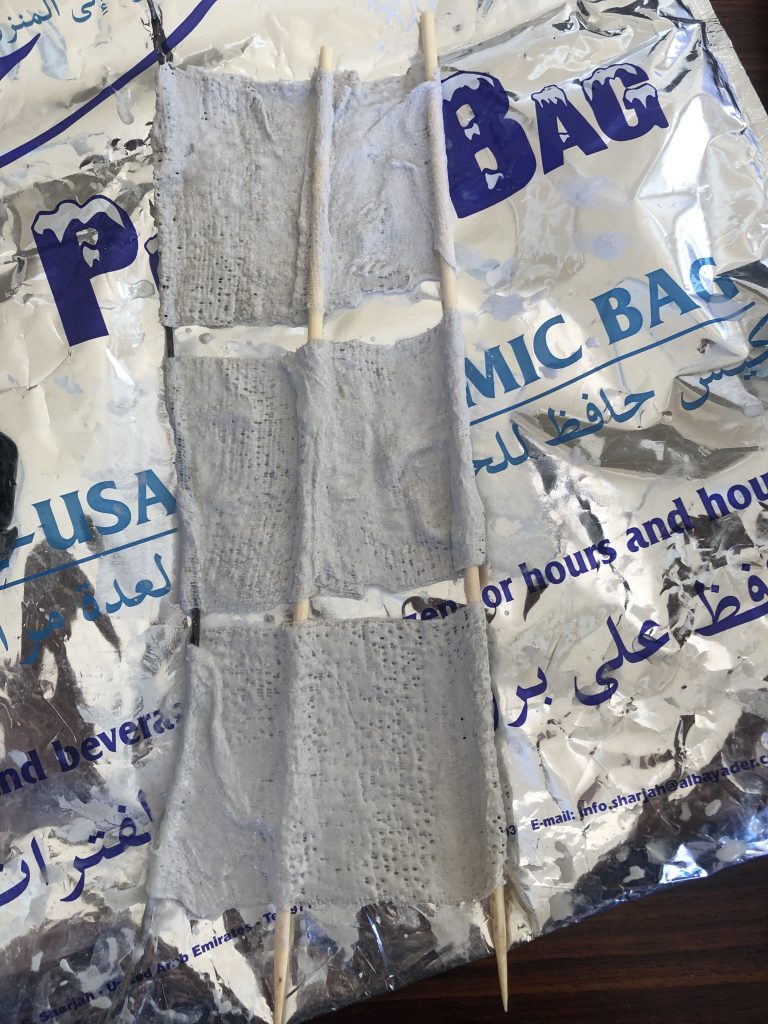
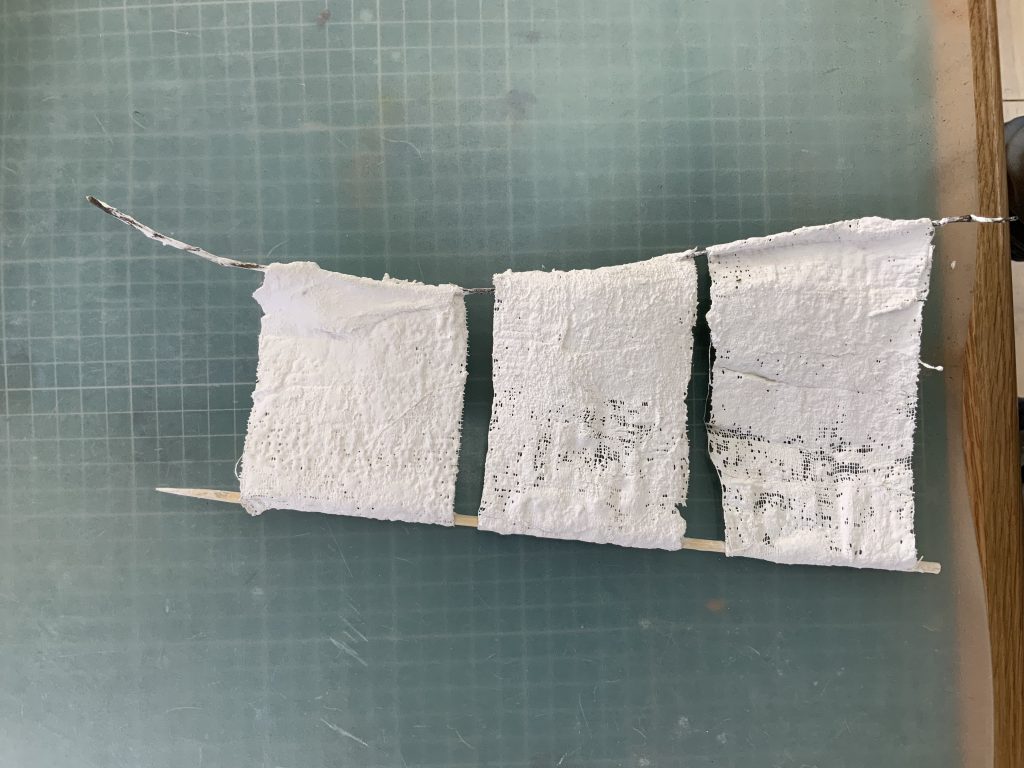
Fig.15 is considering the layout of tea bags as support. I discover that my collection of dried teabags is nowhere to be found (gone lost in our move from Dubai?). For the time being I will leave this investigation. I can consider making my own thin material from other organic things and will do this in my Parallel project.
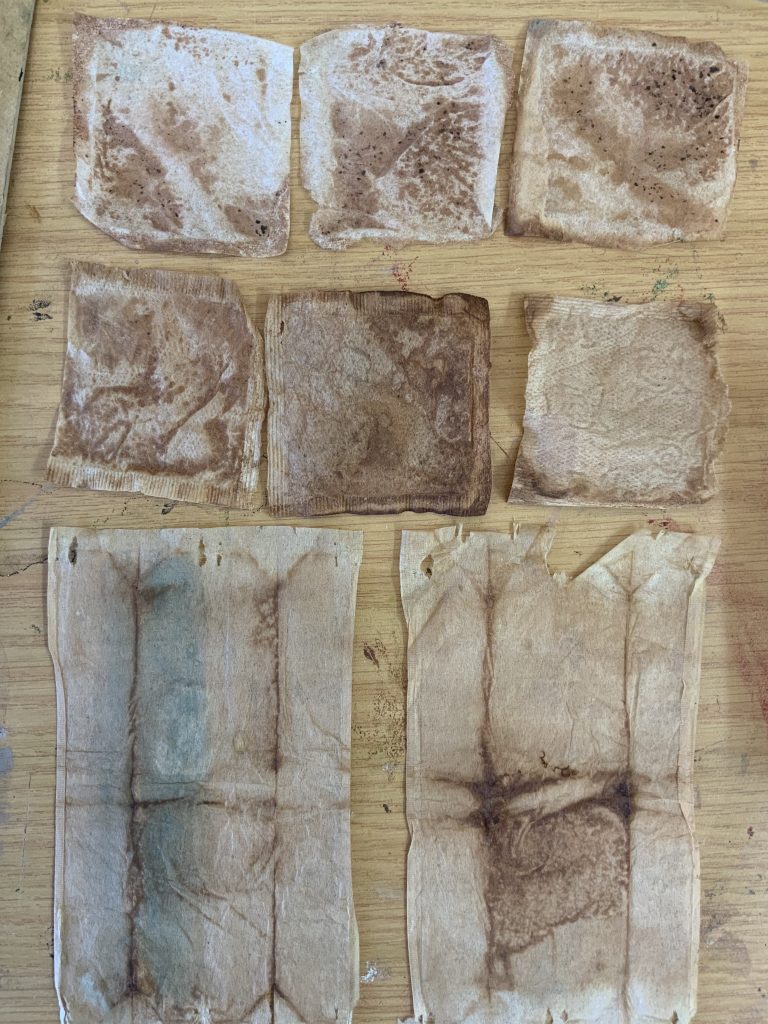
Found items I could consider as supports are my pieces of mostly cotton fabric I use for smearing, cleaning, drying, dusting, in the studio. Some of them have hardened due to materials such as glue that stuck to them, they remind me of a palette whilst painting, showing signs of a brush or palette knife mixing and blending of colours.
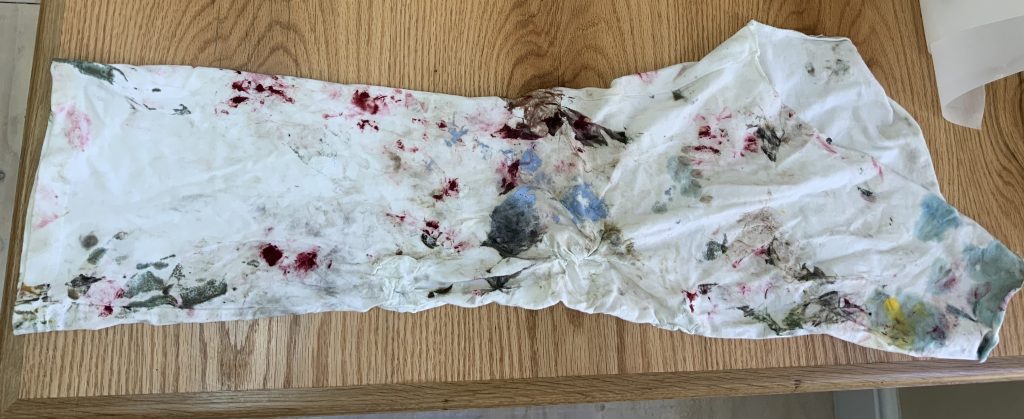
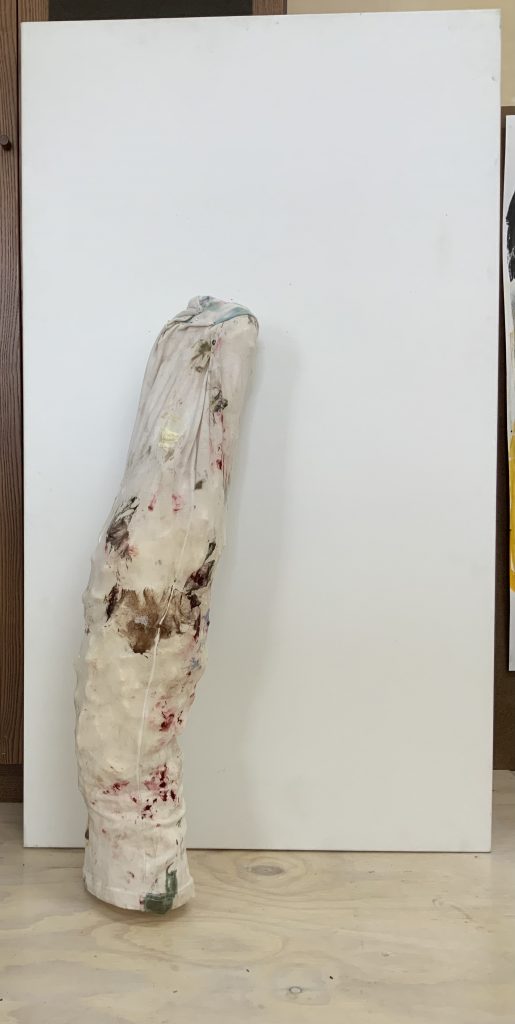
The work of Jim Hodges shown in the study material intrigues me to do some research about his making. On the Stephan Friedman gallery, I read the following: “Hodges’ work explores themes of fragility, temporality, love and death in a highly original and poetic vocabulary. He frequently deploys different materials and techniques: from ready-made objects to traditional media such as graphite and ink.” His work becomes interesting for my own learning in the way that he uses materials, such as curtains woven from artificial silk flowers, metal chains, glass, or using saliva to create ink transfer impressions on paper. (Fig. 14). The work in Fig. 15 is made of glass and is lining canvas 2 inches thick. I found good information on the website of Walker art.org. Here I read conversations between the artist and Olga Viso (the then museum director and curator) (Viso 2014)
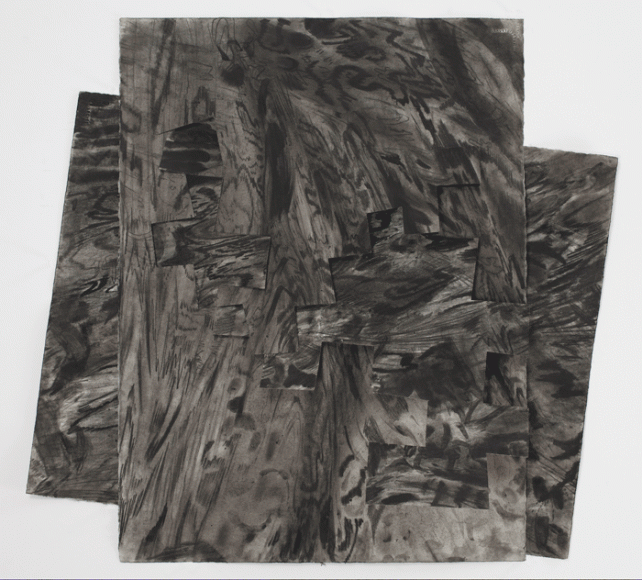
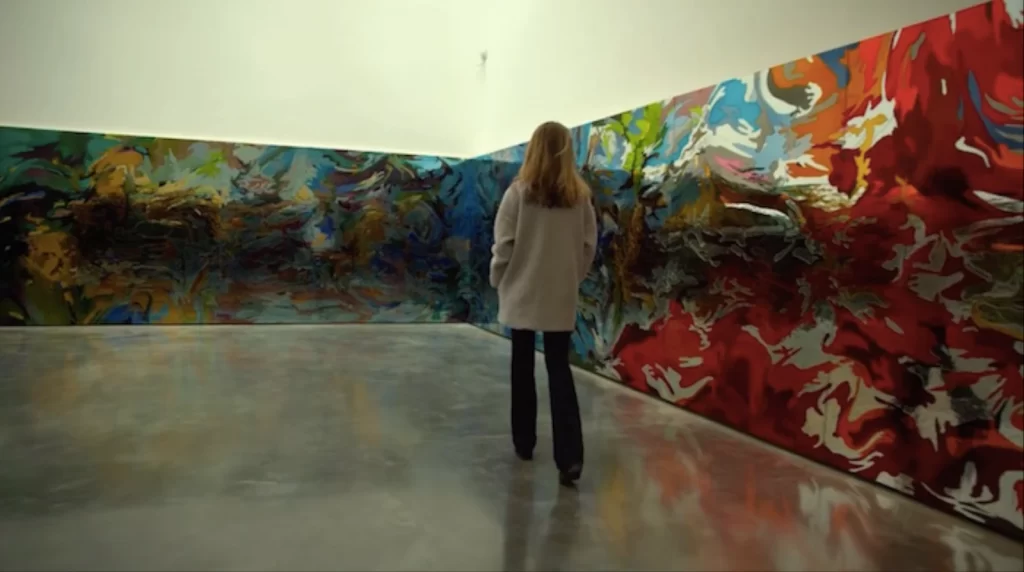
Looking at a small canvas, not feeling too particular indifferent to de(construct)stroy it for the sake of making me think of standing in front of a blank canvas and all the mishaps that could follow.
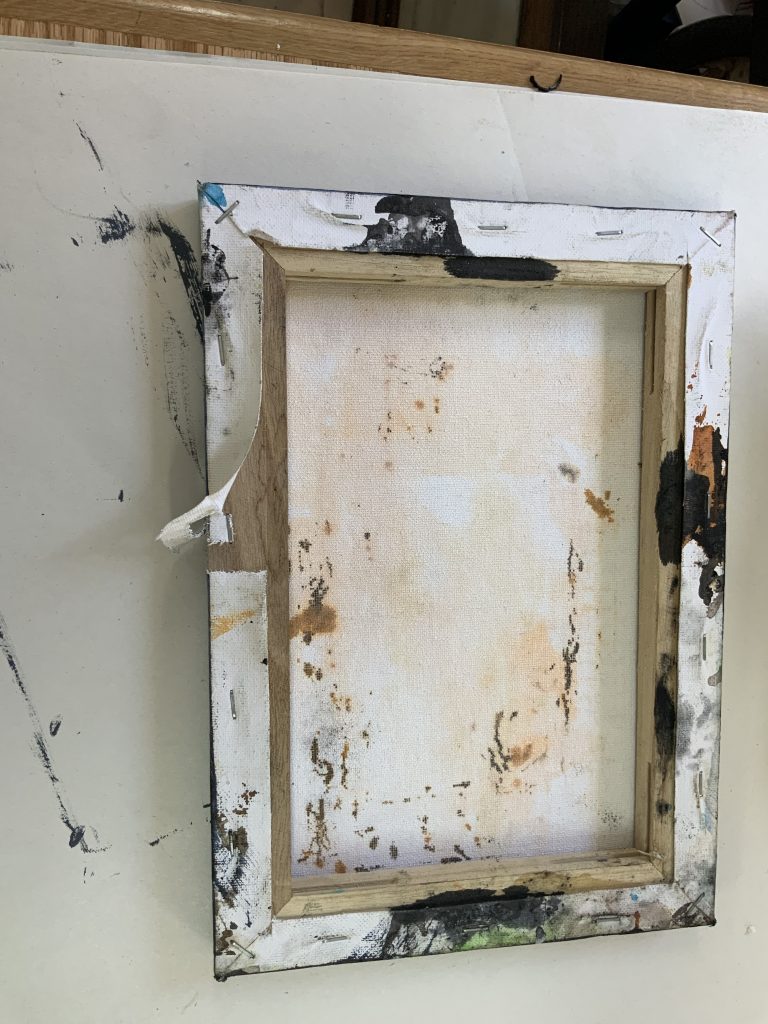
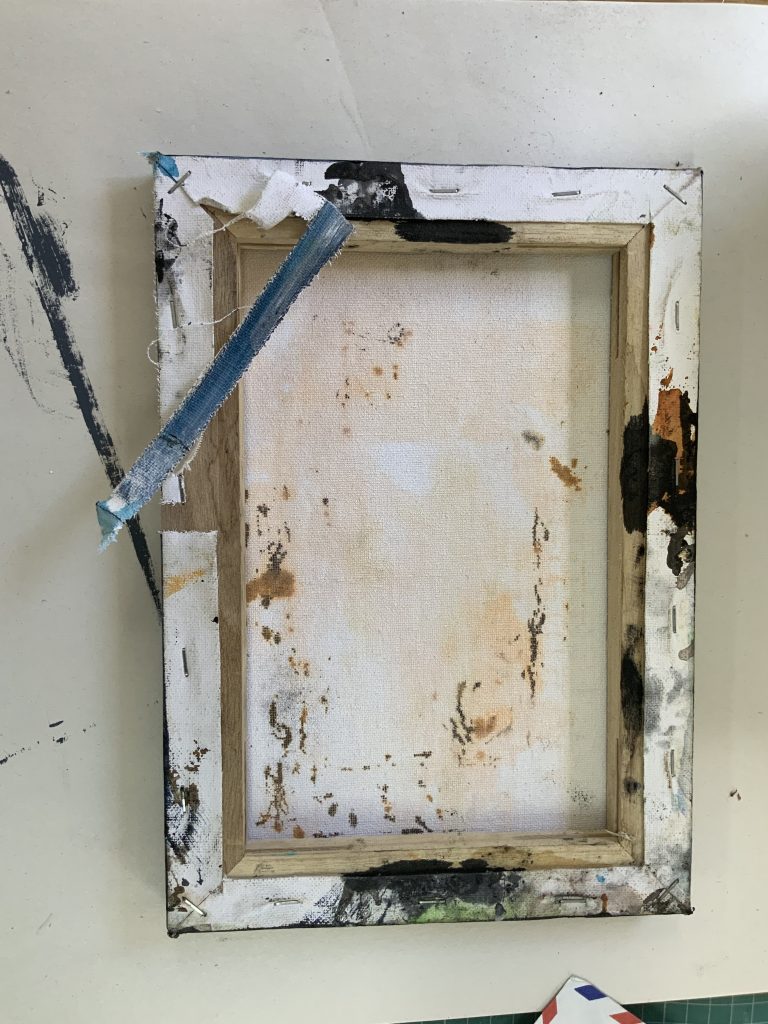
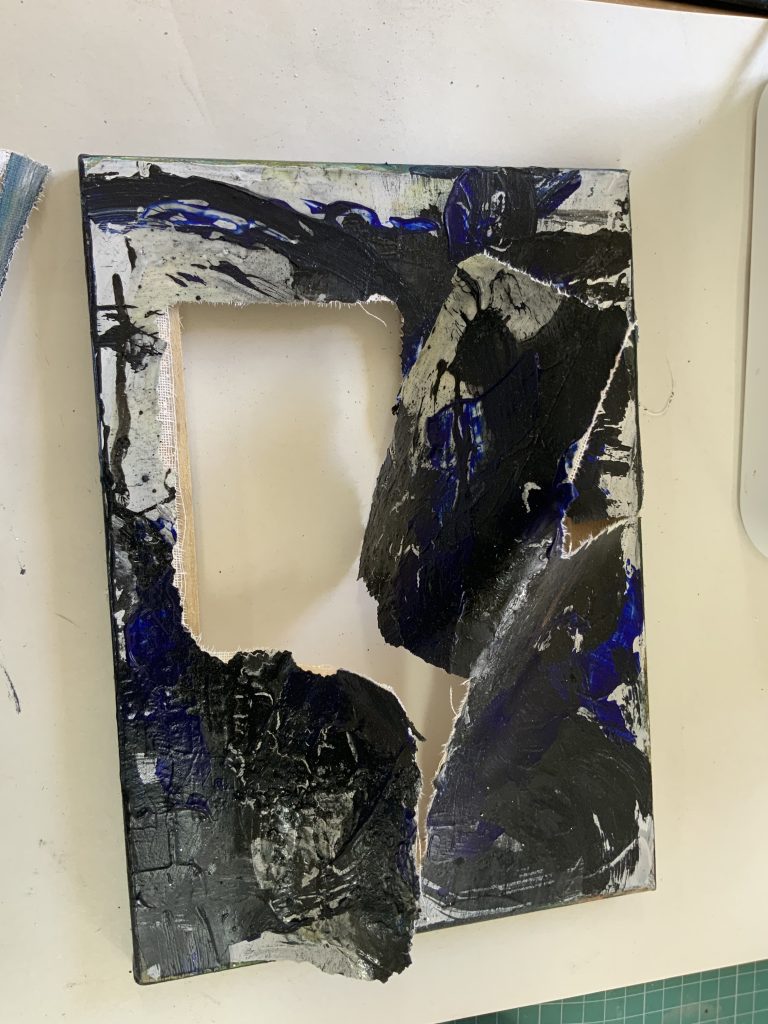
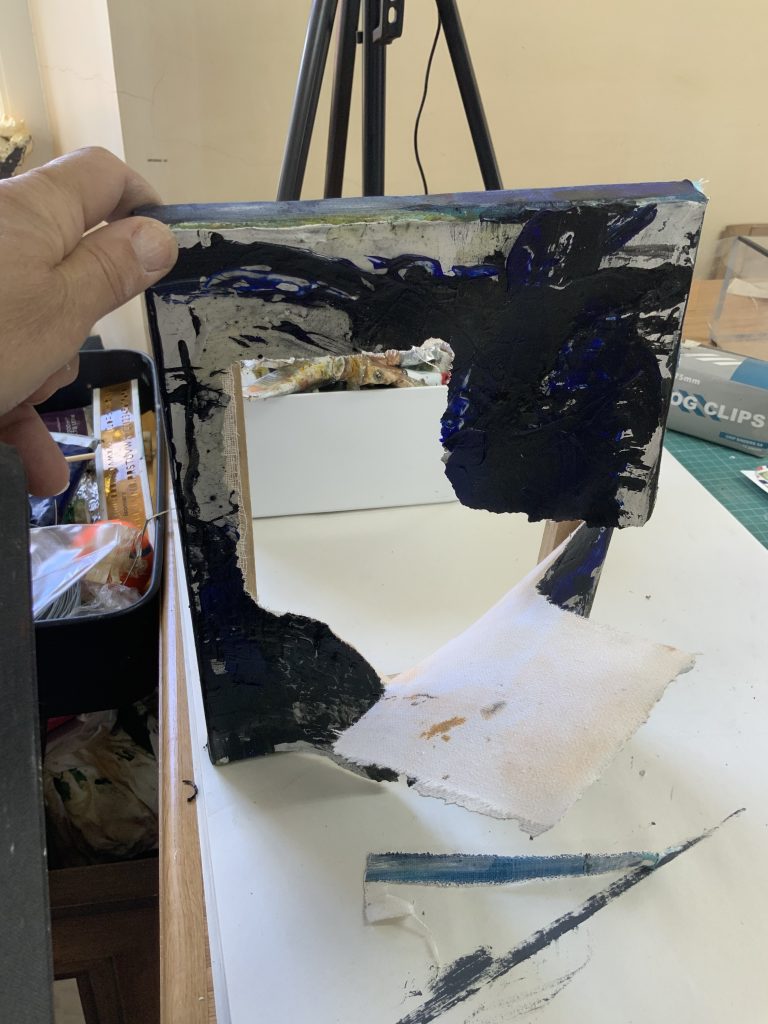
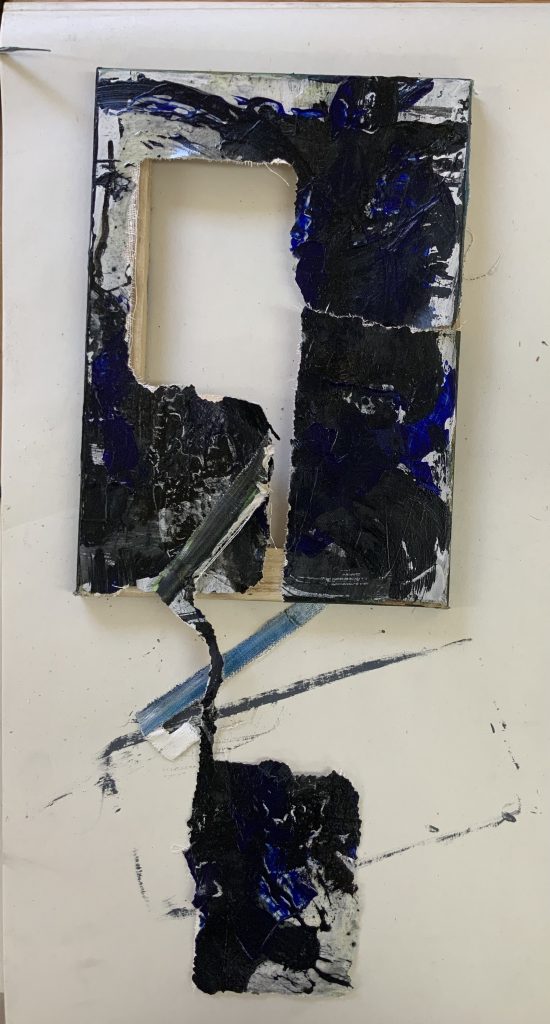
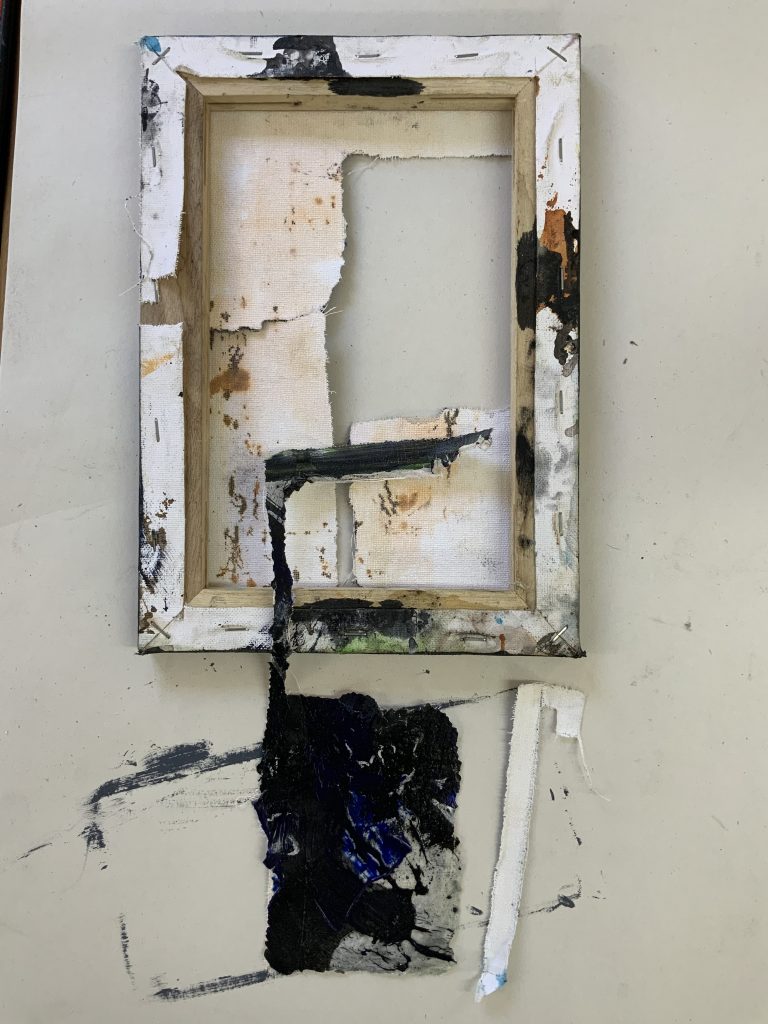
I have found the work of a Hungarian born artist, Simon Hantaï who invented a technique called le pliage come methode, (folding as method).
On the Artforum website, I found an article on the working method, by Molly Warnock, which will attempt to follow in my making. It seems he was also associated with the Surrealists in his earlier career, by 1955 he became strongly influenced by the Abstract Expressionists and Pollock’s action paintings. On the Gagosian website, I read that he would crumple and knot or fold the canvas and then uniformly paint over it, or douse it in oil paint, then spread it out to reveal a matrix of alternations between pigment and ground. This technique dominated his work for the rest of his career, he would diverge forms and composition – work in monochrome and on unprimed canvas. On their website, Gagosian refer to Gilles Deleuze, when they quote him: “Folding-unfolding no longer simply means tension-release, contraction-dilation, but enveloping-developing, involution-evolution. An according to them, Hantai made the following remark on his le pliage method: “When I am folding, I am objective and that allows me to lose myself. I found the
According to Warnock, ( ) the canvas, while unstretched was given a layer of white gesso, and then crumpled tightly, from edge to edge. He would then flatten this irregular folded form on the floor and flatten it further with a rolling drum (heavy) which then leaves the multiple folds intact, but creates a new surface plane; onto which he would then paint, apparently with oil paint.
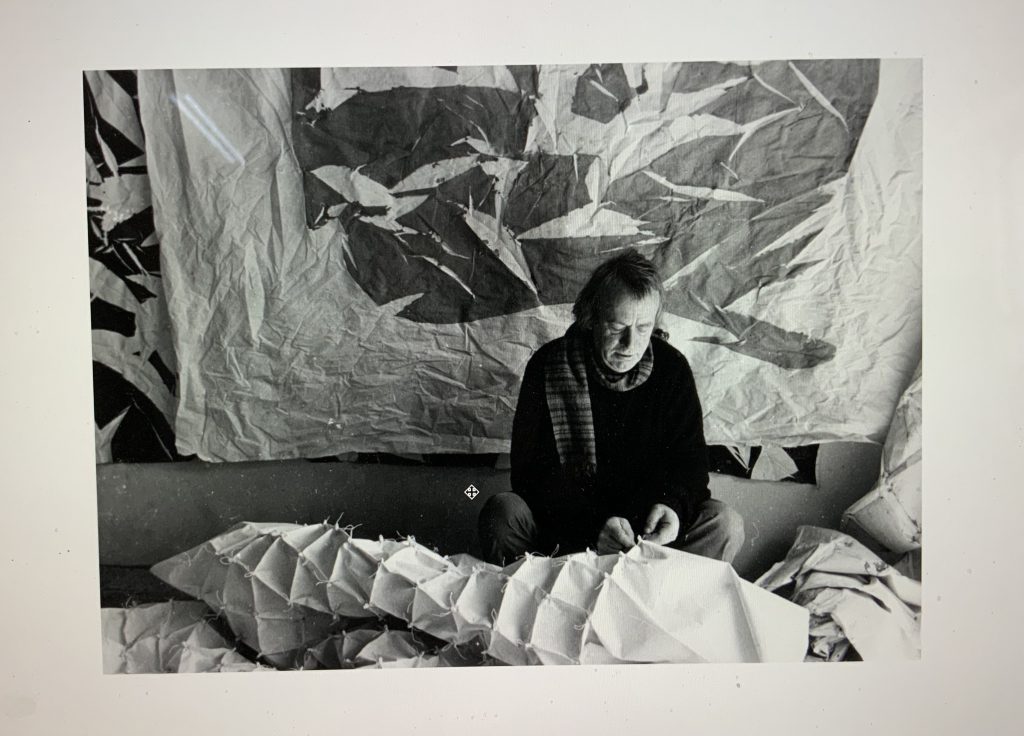
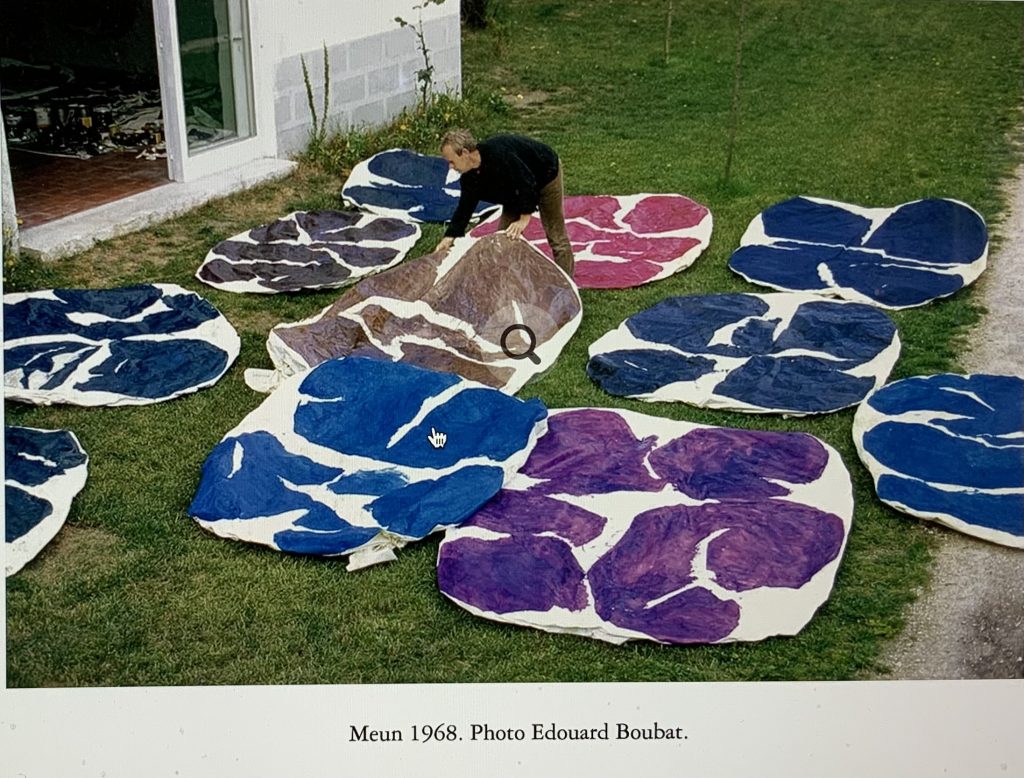
I first made a sample with paper and soft pastels. then a small piece of cotton fabric and then worked on a larger sheet of cotton ( I do not have the canvas in roll form). All the surfaces were covered with gesso. The bigger surface was flat on the floor and I placed it on an old plastic sheet and then added some drafting paper between the plastic and the fabric. This created a nice folded pattern, and I decided not to crease further.
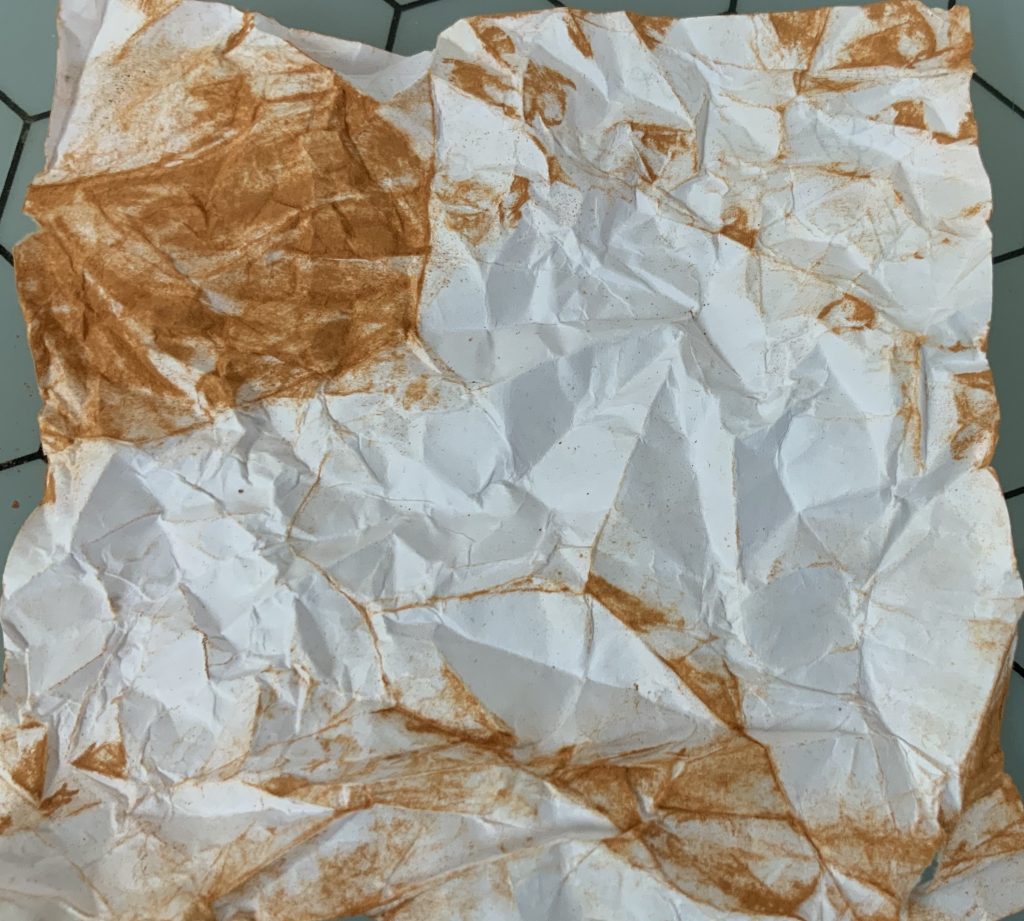
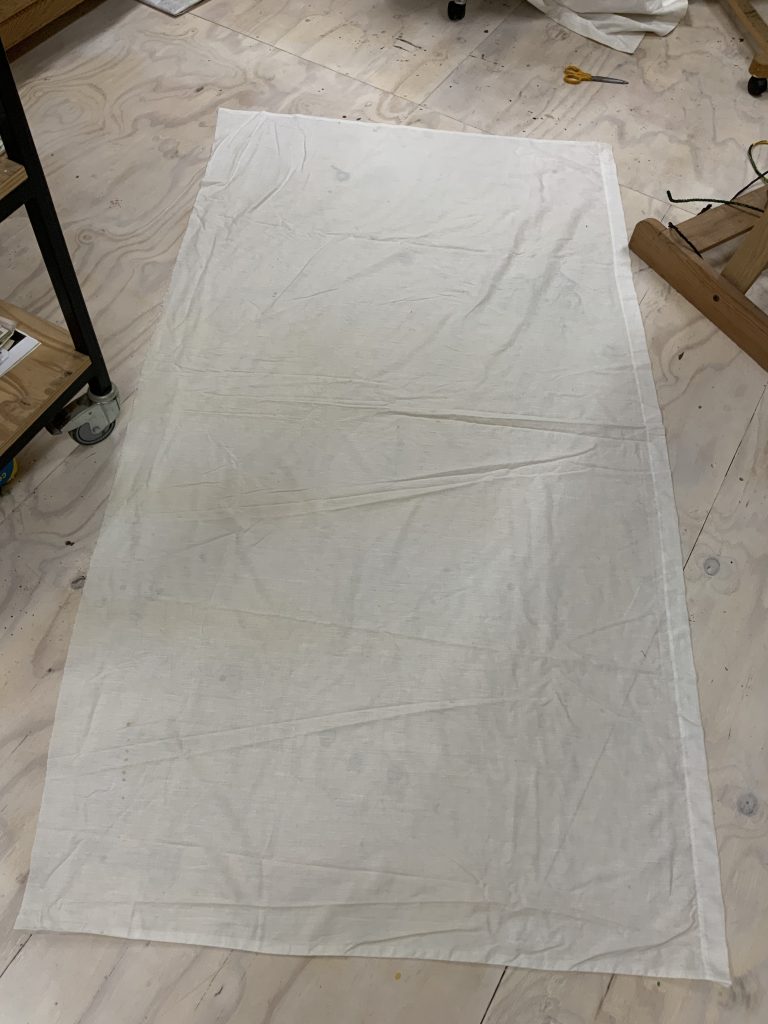
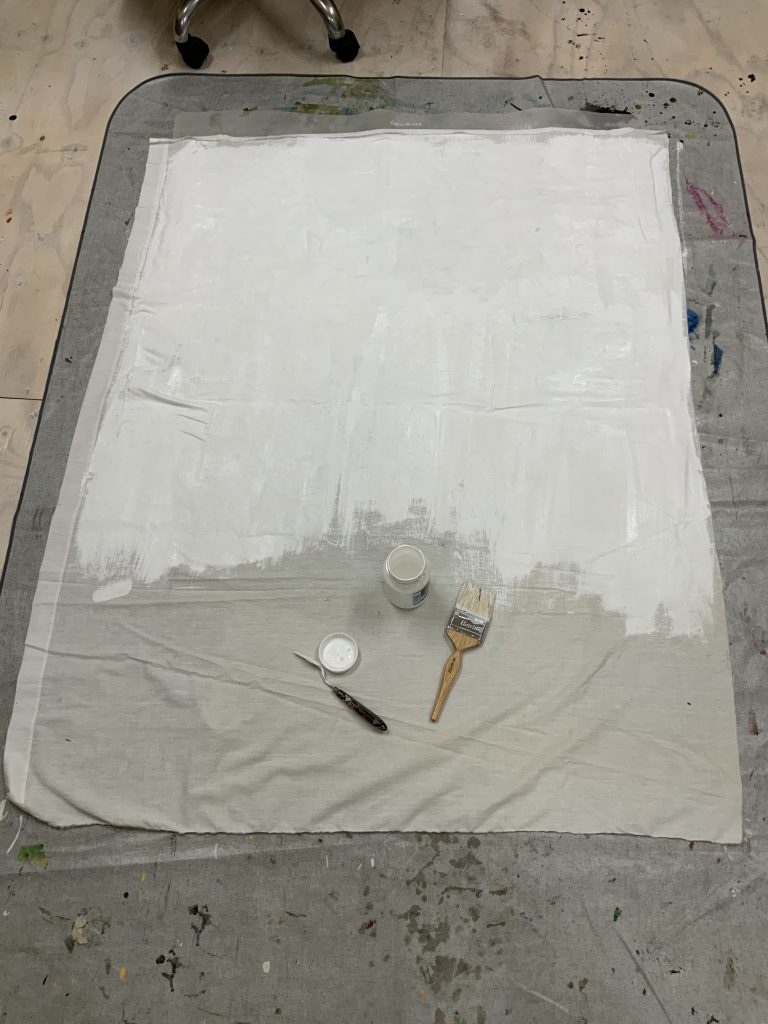
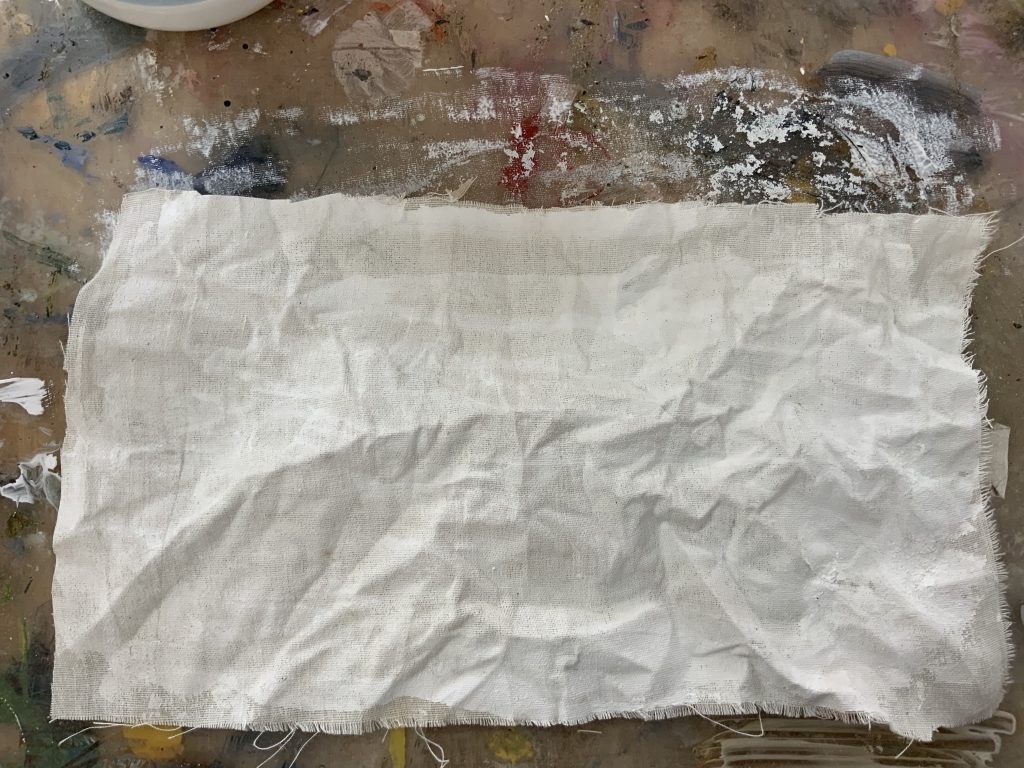
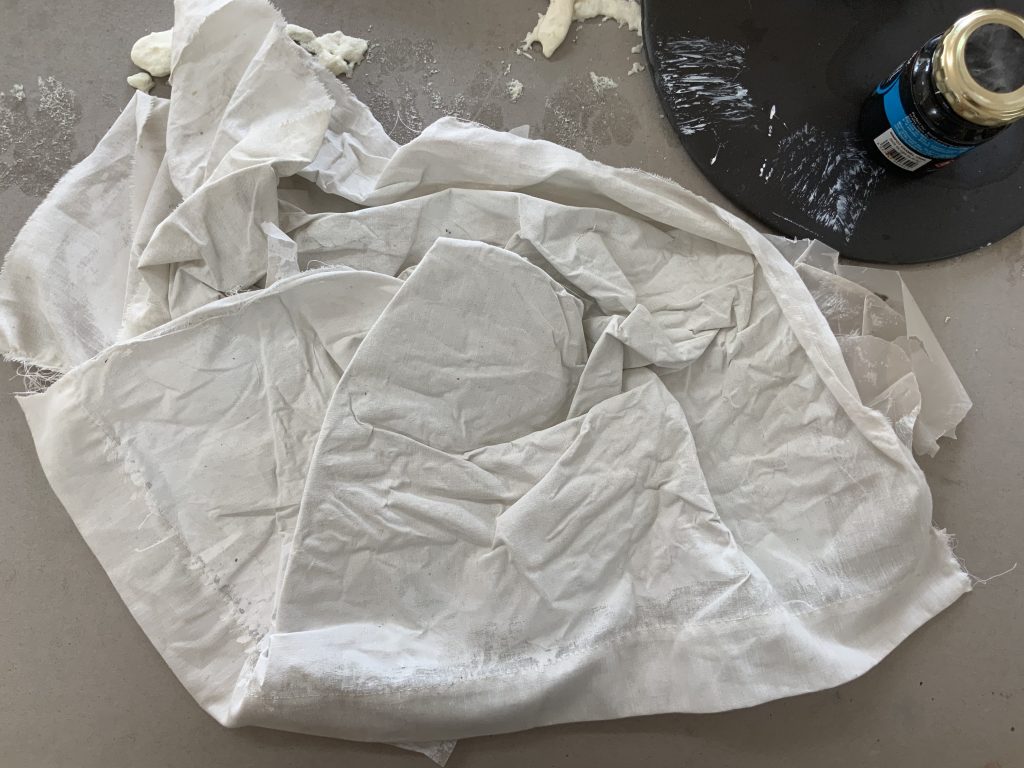

I have plain cotton fabric to explore with. Origin is that of old curtains that I stopped using for its purpose.
The smaller sample size was folded and creased and I then painted enamel household paint onto it. Below is a video of my making process.
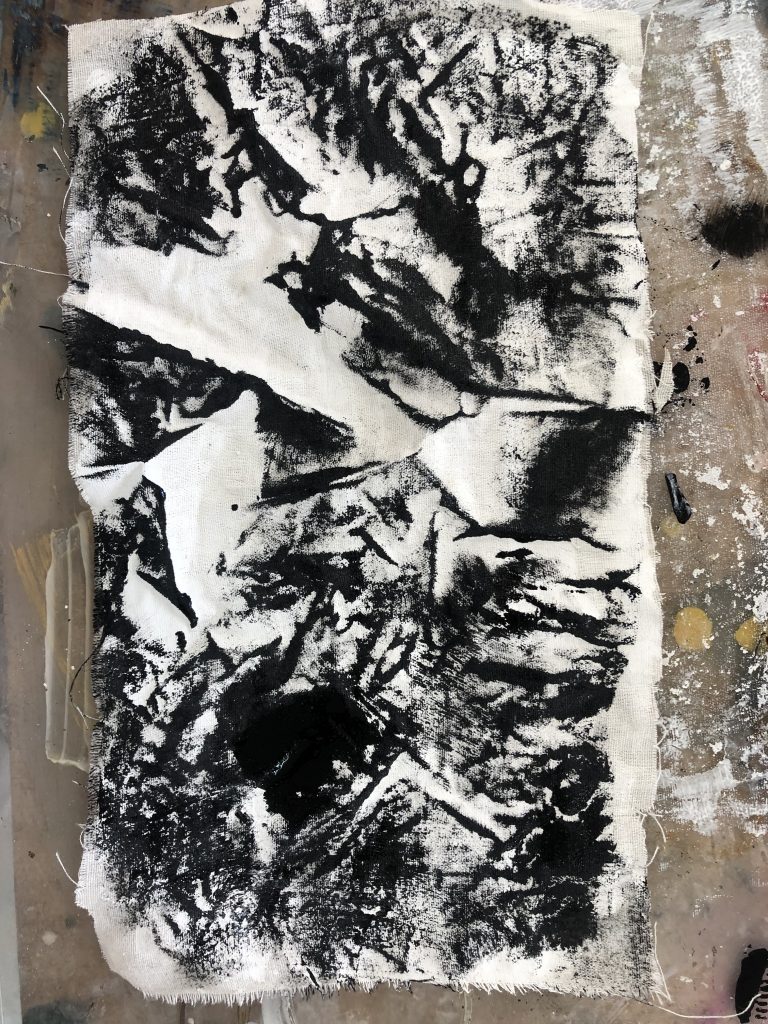
I added more colours to the bigger canvas and in the end, cut it into two canvases. I used a big brush but did not manage to get the paint in the same tonality/evenly onto the canvas – the paint is thick and sticky and sometimes I loaded too much onto the brush. I experimented by dipping the brush into OMS, but did not think this was a good outcome – the canvas looks more like a charcoal drawing to me.
The different colours on the canvas remind me of the work of Jackson Pollock, could it be the depth illusion which the folds create and that reminds me of layers as in Pollock’s action paintings? The coloured paint is a cheap student brand and did not sit well on the support.
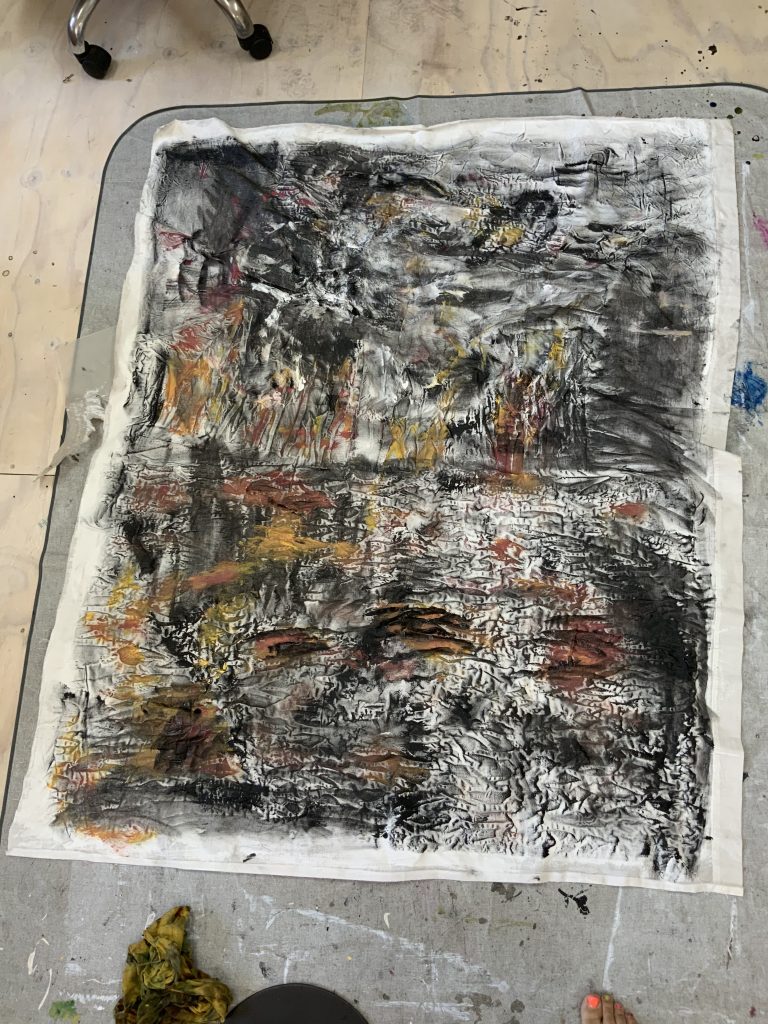

I tried another smaller piece – acrylic on white gessoed cotton fabric. I like the blue/grey and ochre/sienna mixture of colours.
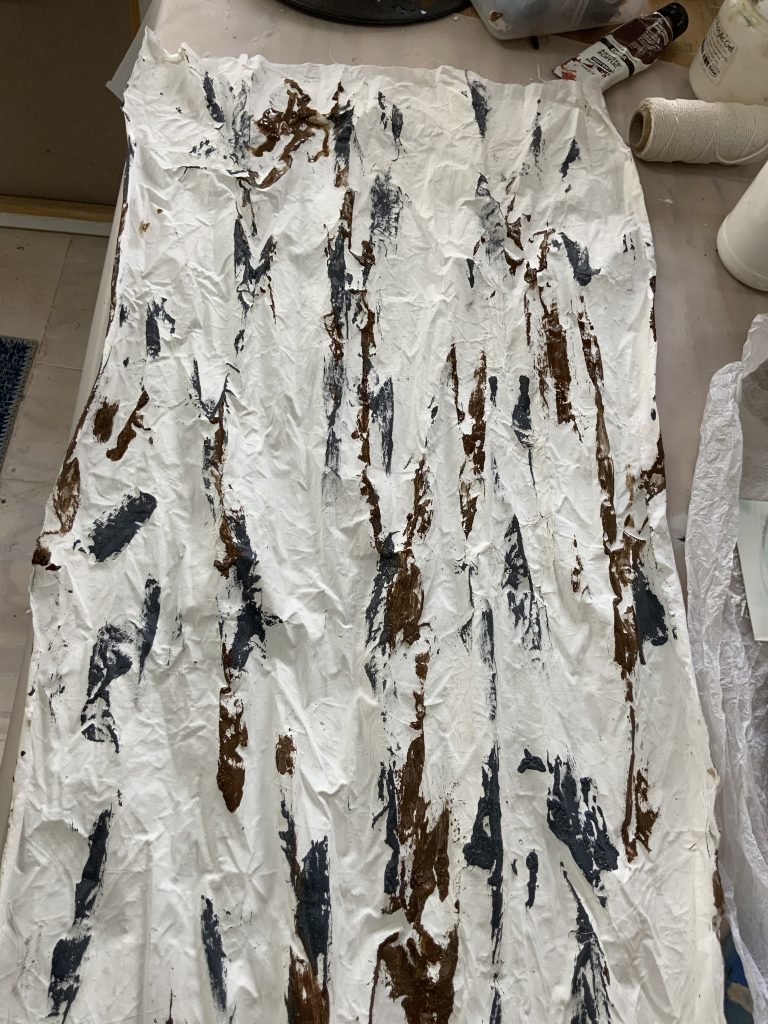
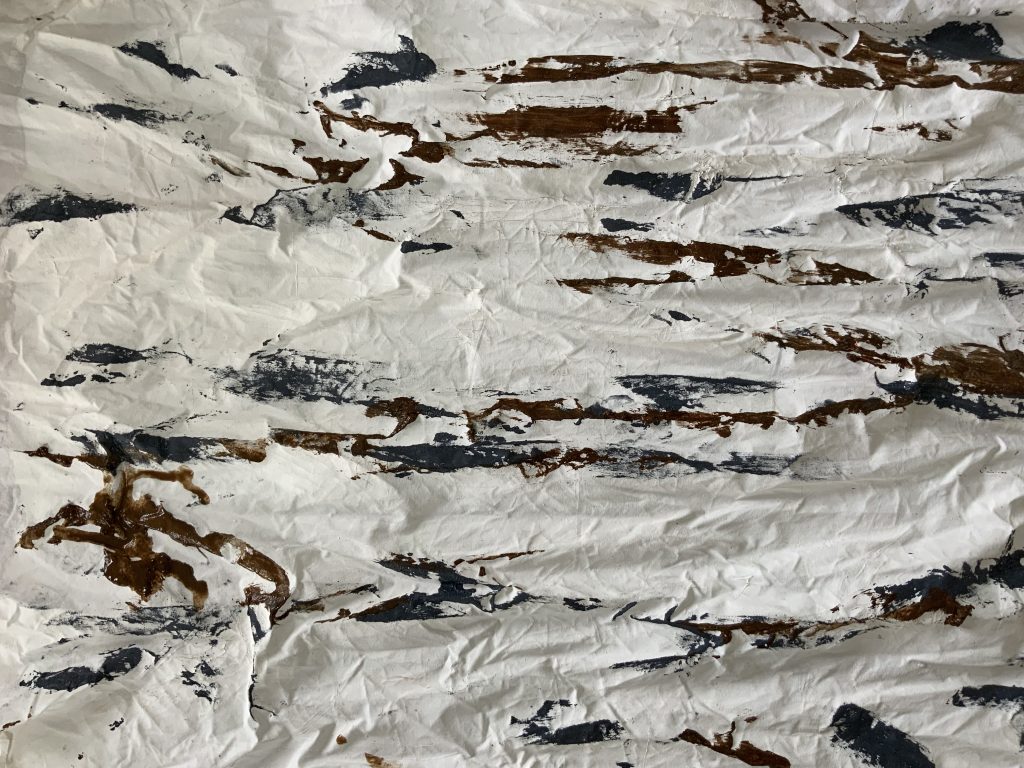
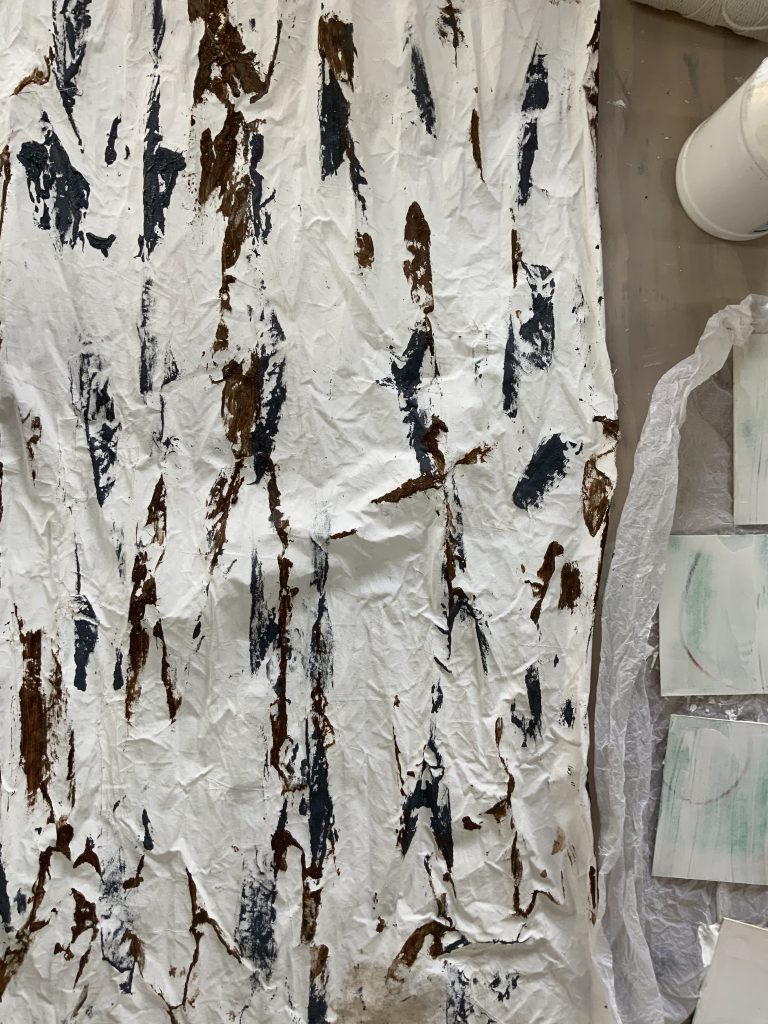
I do think the mark-making is strongly influenced by the surface as it is creased and folded. I like the samples of colours and different marks that I have assembled. I do think I could work more with these ‘canvases’. Some remind me of landscapes or just atmospheric places. I am not sure if I can even say – but to me the meaninglessness of the work is exciting. I think of gestures and actions around the making process, a lot had to do with them; to find, to cut, to fold, to crease, to paint…… I put some of these actions, videos, and images onto my social media, Instagram account, and the reaction of viewers were comments like ‘expressive’, looks good, creative…., nice. I see this as a formal process of working, an action within the making. Folds can conceptually also indicate an illusion and become a revealing process: if one does a performance, one could start with the folded work, unfold it to reveal. I think it talks about the control of the artist.
I looked at fabric with patterns or coloured. I have some locally bought fabrics which relate to the TshiVenda culture who mostly live in the Northern parts of South Africa. I lived in this part of our country many years ago and bought some of the fabrics with the idea to make something with them. (I made blinds and some clothing) I think these types of fabrics speak to being Afrocentric and about origin, heritage, and tradition. In this thought, I cannot whilst considering painting onto it, but think about the power of paint to conceal and disrupt the canvas and how I can use this fabric in a new form.
I read an article on the Guggenheim website about the artist, Daniel Buren, who in the late 1960s explored striped canvasses, and in the end, lead him to use the stripes as a “visual tool” whose function is to reveal, through its placement, the characteristics of the site in which it is displayed. 1 Buren is known for “examining” how an object or sign is transformed as it traverses physical and conceptual boundaries. It seems that as a young conceptual artist, he was considered visually and spatially audacious. He objected to traditional ways of presenting art through the museum-gallery system when he connected to deconstructionist philosophies of the late 1960s.
By replacing his canvases with standard awning fabrics, Buren also questioned the idea of a personal artistic style. The vertical stripes were either in canvas or paper, alternately white and color, or alternating stripes of white and transparent plastic, 20 works, each with stripes of 8.7 centimeters wide. The height, breadth, and shape of each piece vary according to the site.
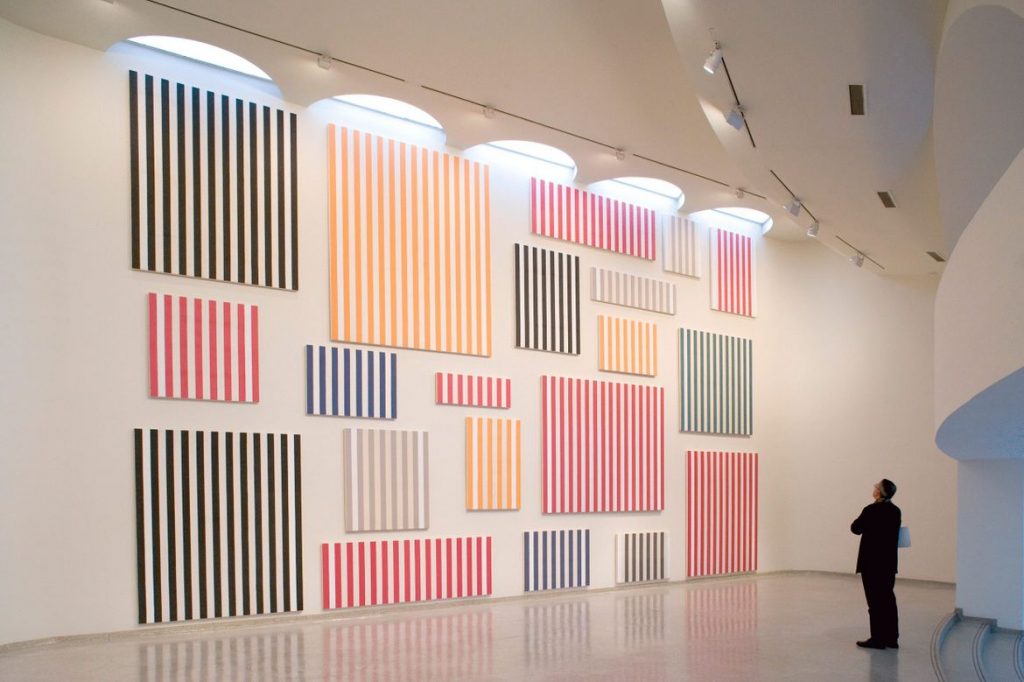
Guggenheim Foundation, New York
20 canvases
Acrylic painting on cotton canvas
Alternating stripes 8.7 cm wide each. (photograph by David Heald
According to a conversation between Buren and Jerome Sans (1998) Buren did not consider the origin or history of the pattern of choice, to him, it was a found object. I also learned that he creates new bodies of work for every exhibition, in this way, the work is always in situ (site-specific) work. He sets rules to keep to this practice: at the closing of a show, his works are either entirely destroyed or attached to a set of rules that determine future placement. He explained it as follows in the interview with Emily McDermott: “For me, it’s not only to work with the architecture and space, it’s also to work with the time, to work with the people who are involved with the place. It’s also dealing with history. It takes all this into account.”
It is interesting to now ‘get’ how stripes are used to relate to fashion (images below, Venda ladies and their culture in fig. ), commerce, safety, law enforcement, and patriotism (flags). The striped cloth is named ‘wenda‘ cloth and has mostly replaced goat and sheepskin aprons the VhaVenda women used earlier, as well as the later white and black striped fabrics, which I have not looked into (https://www.vukuzenzele.gov.za/venda-traditional-dress) A quick Google search shows the printed fabric and how it is traditionally worn by women. See the images below. Mashinge and Raphalalani write about an important need in Socio-cultural studies, to “…..reassess the cultural meaning and significance of dress codes as a means for self-expression and identification.” (2018) In this article they allude to an opinion that African clothing and culture around dress codes are “highly charged discursive space of a globalizing… [environment] that is insidiously hegemonic”. One gets the impression of how the social construction of meaning and cultural signification is embedded in each type of attire, and that ‘otherness’ could come into play when we look at African cultural history.
It does take me to context and conceptual thoughts – what do I want to state if I present this as a work of art? I am reminded of earlier research into the work of Yinka Shonibare and how he showed that African fabrics have a history of multinational and cultural background – fabrics are made in other foreign countries, sold in masse and not all is handmade any longer. ( see my blog). We have a world trade ongoing, and the market adapted in Africa as well. I would like to stay sensitive to the cultural significance of the fabric, and I think that is why I would prefer to use the fabric as part of an exploration of using a patterned material as a canvas. I will explore how paint sits on a printed fabric which I chose from my own selection of fabrics (found objects) and also use other fabrics I have for this project. In a discussion with a fellow student at OCA, she commented that identity and culture are very contaminated together, and asks the following question, ‘when does something belong to a person or to a culture?’ I think it is clear that art is embedded in social and cultural practices.
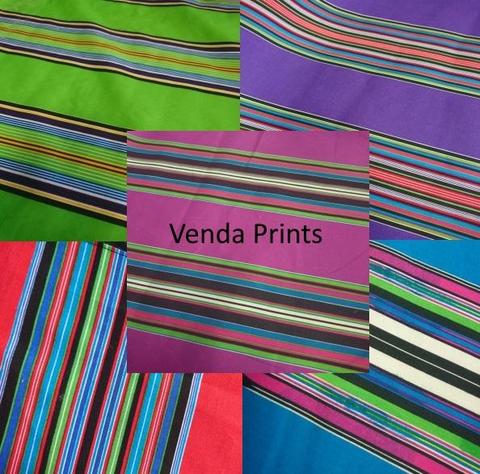
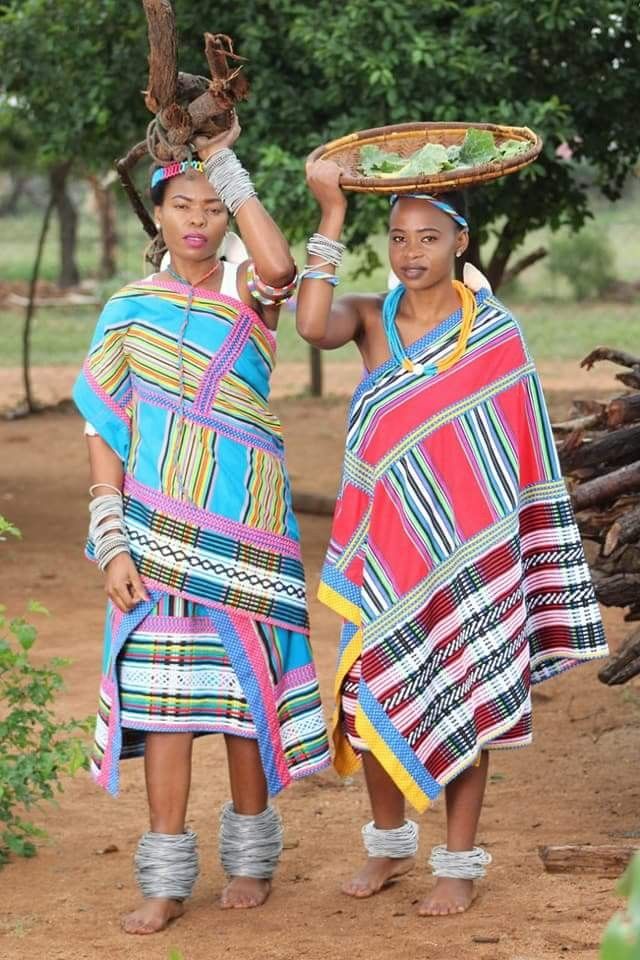
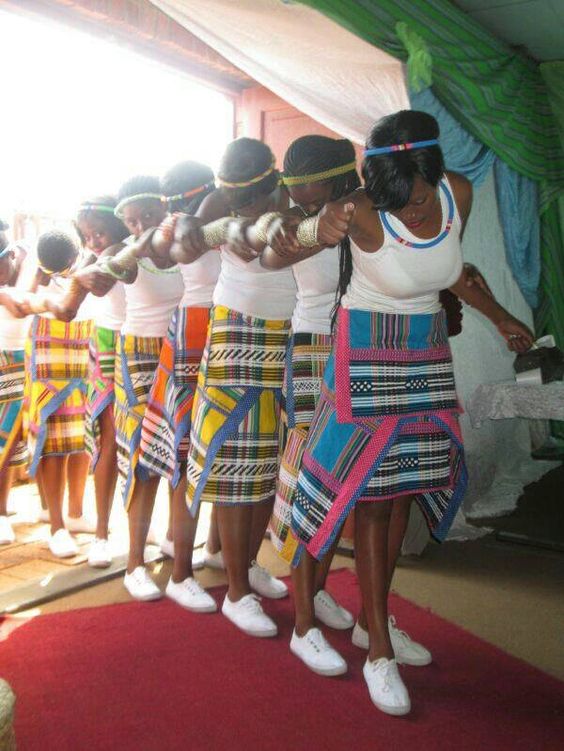
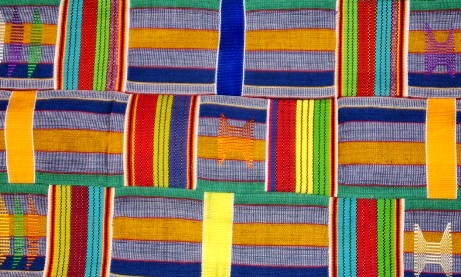
I consider how I could use some found fabrics and wool I have been keeping in a big plastic bin. I would like to make a work considering it as my canvas and not use support. In the below images I have draped it over a canvas for the purposes of showing it to my reader and contemplating how I could re-interpret it.
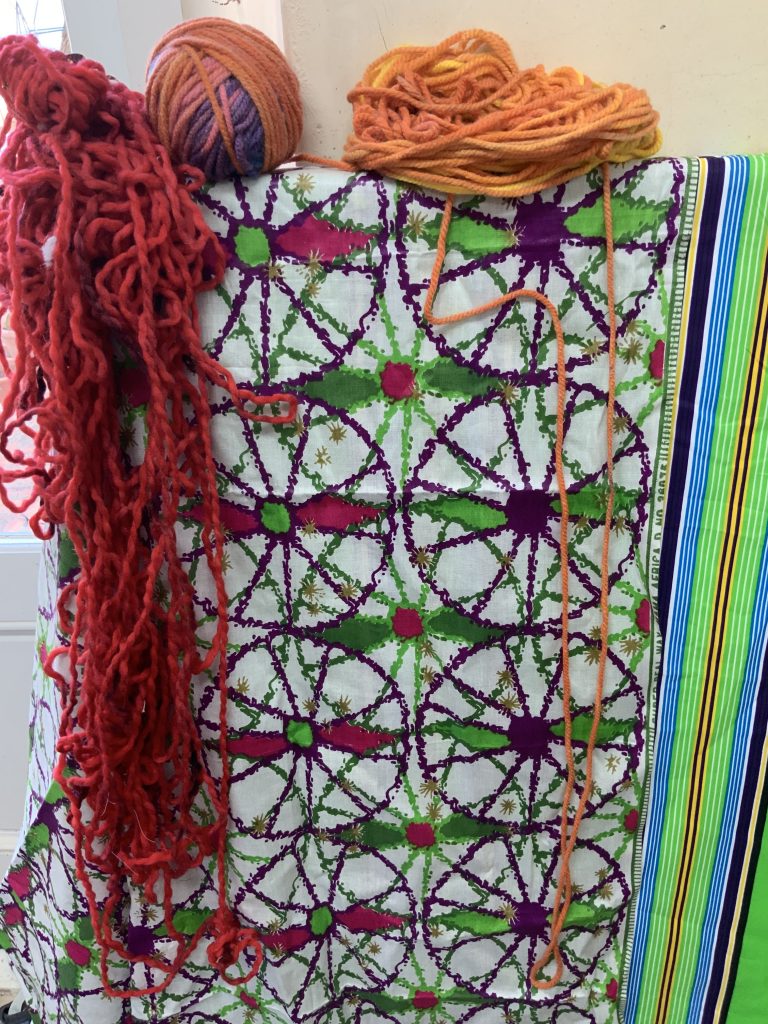
The images I found on the Artsy website by artist, Sheil Hicks are very inspiring.
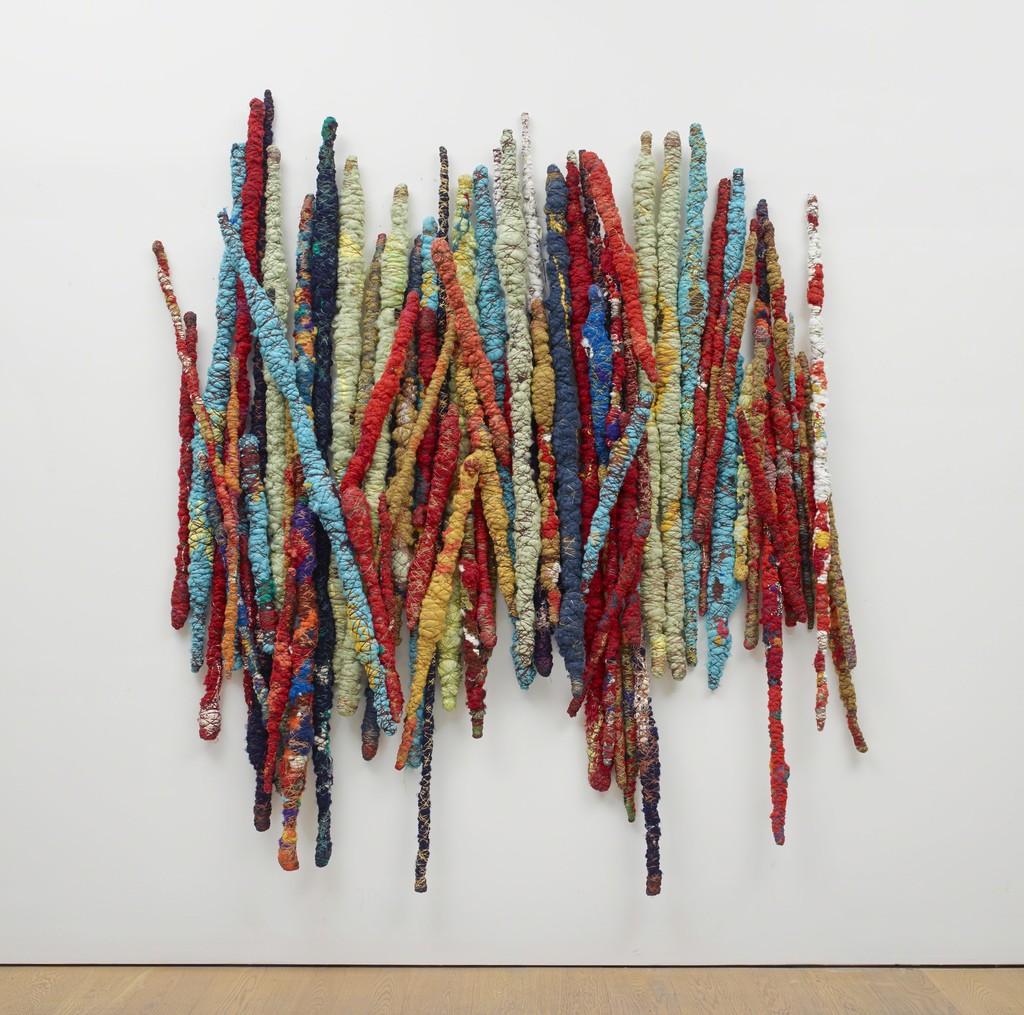
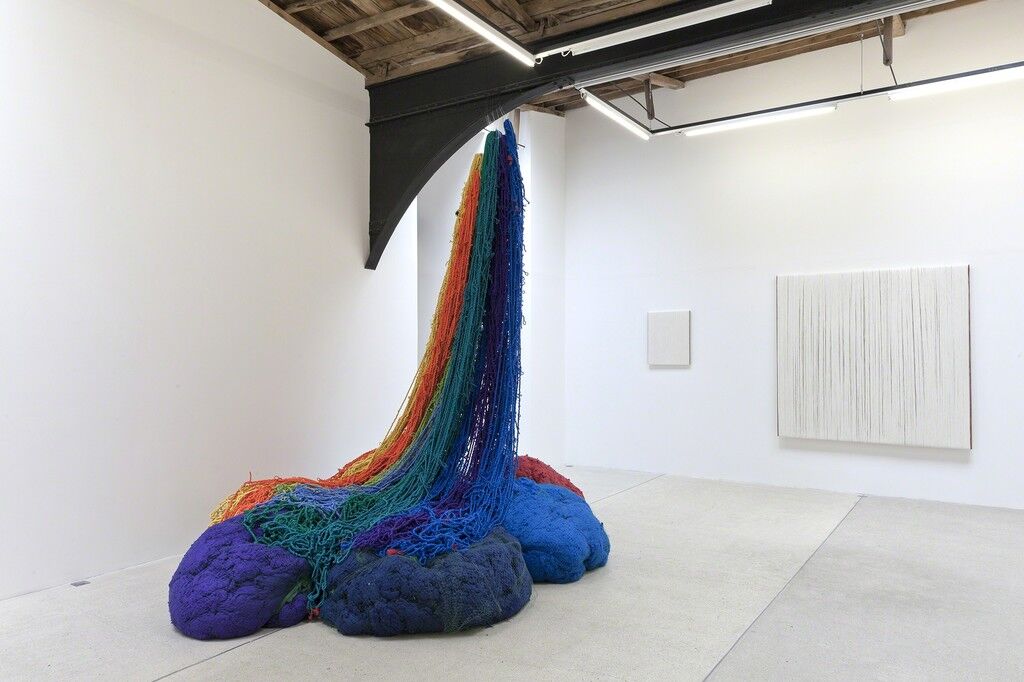
I decided to paint on a part of the striped fabric, the size is 85 x 112 cm. I will paint white stripes and start by laying down a layer of gesso. I wonder if the ground will add to the opacity of the white on the coloured canvas? It will be interesting to see if it will give “tooth” to the surface so that the white paint will “stick” to the fabric. Great that it does not have to be soaked in the canvas, such an easy way to prime the canvas, and is supposed to help with the absorption of the paint; this is cost-effective. I have learned that gesso is a good cover-up when I make mistakes or did not like how the work turned out, works like an eraser.
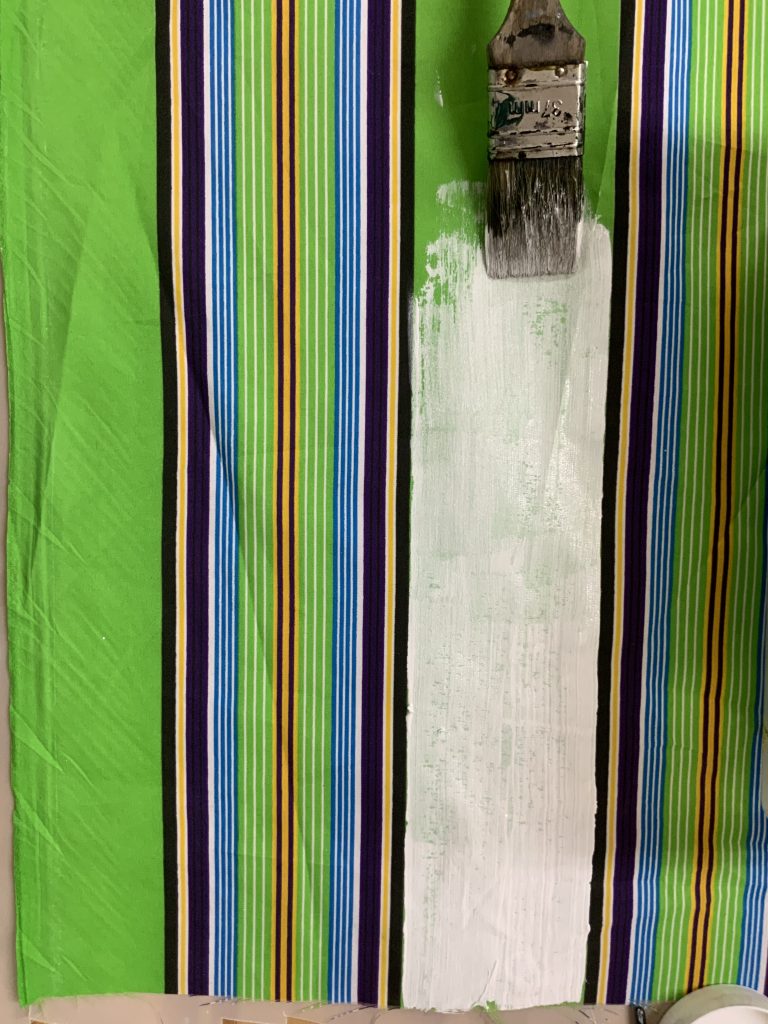
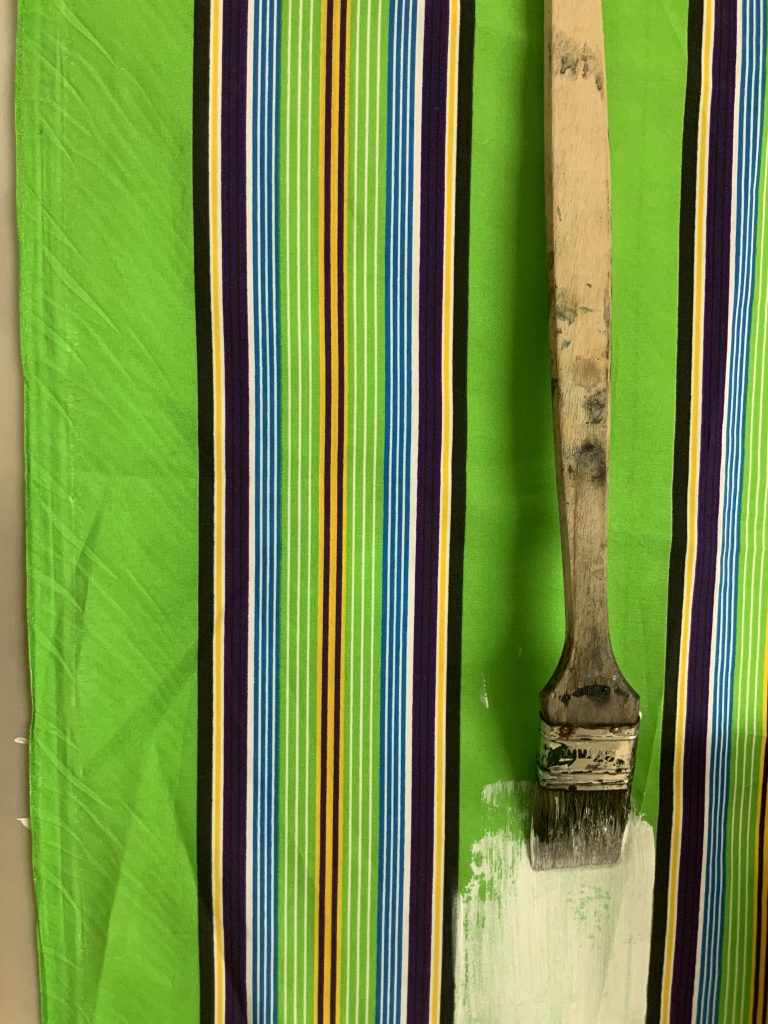
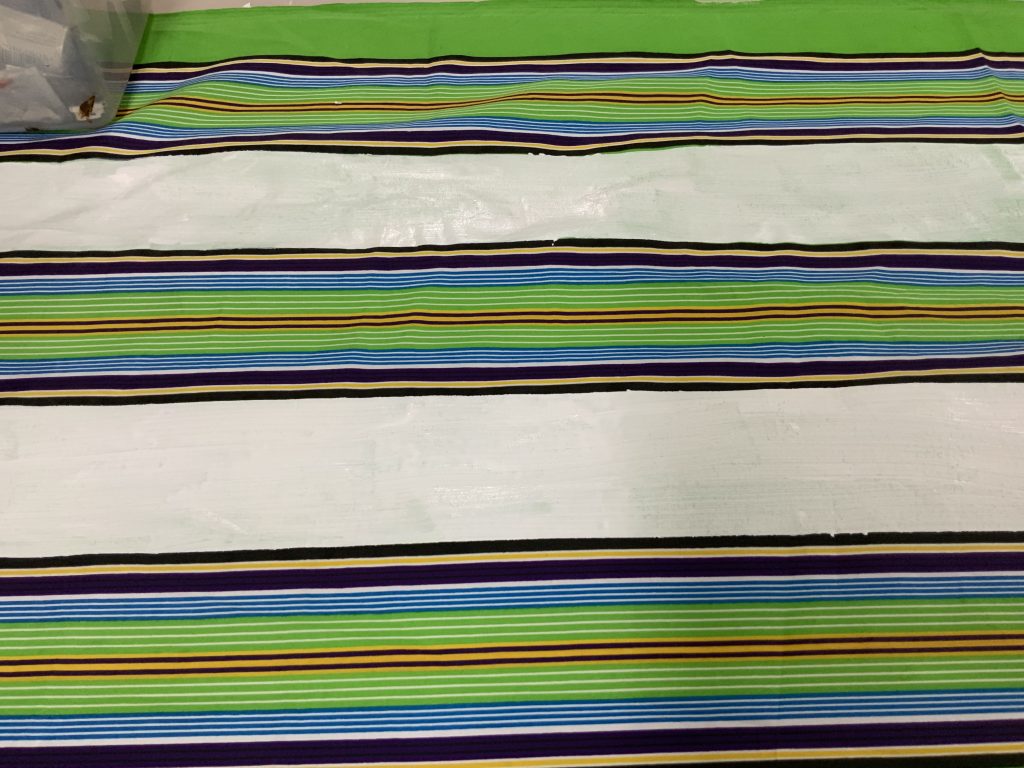
What I did learn by now from this making is that because the fabric is dyed, the front and back look the same, however, my painted area still reveals the original green dye at the back. So am I allowed to conclude that the gesso and paint did not cover all of the original fabric, only that which is shown as the painting? ..and that..on the inside (that which the viewer will not see) all is still the same? It made me consider the preparation of the canvas before applying paint. Over the years I have loved to tone a primed canvas. I learned that oil paint seeps into the material if it is not primed and that this might end up one using much more paint (cost-ineffective way?). Below are three images, showing the front and back of the painting, and then I did samples with acrylic and oil paint. On figure the middle sample, which is oil without priming with gesso, seeps into the fabric.

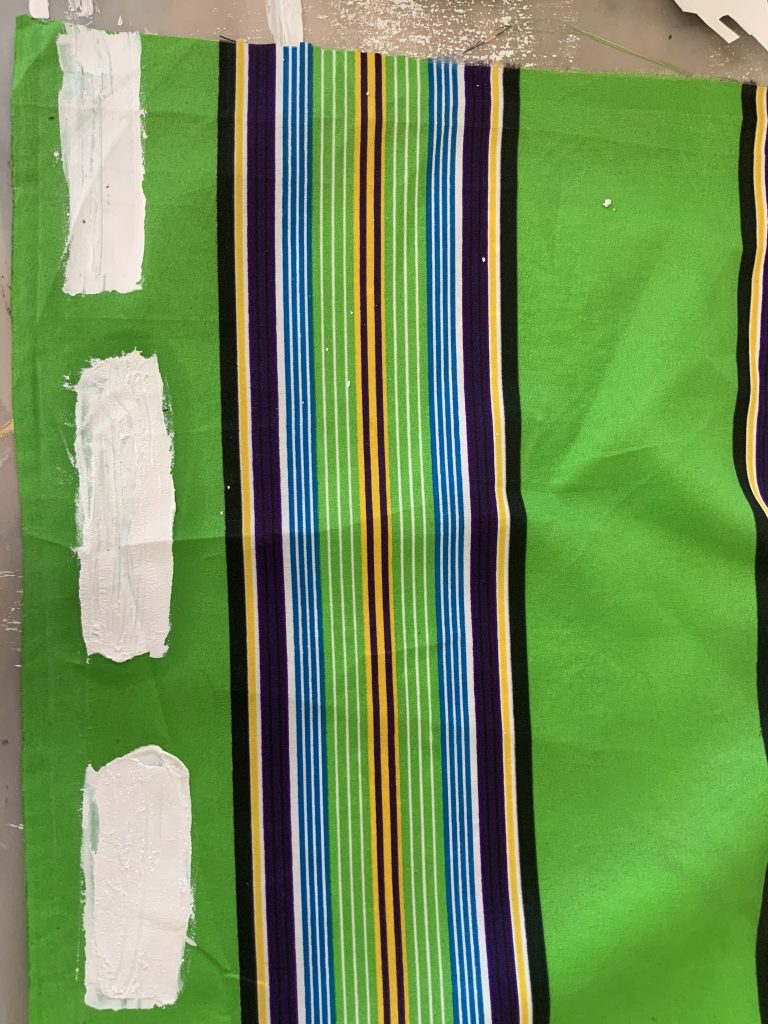
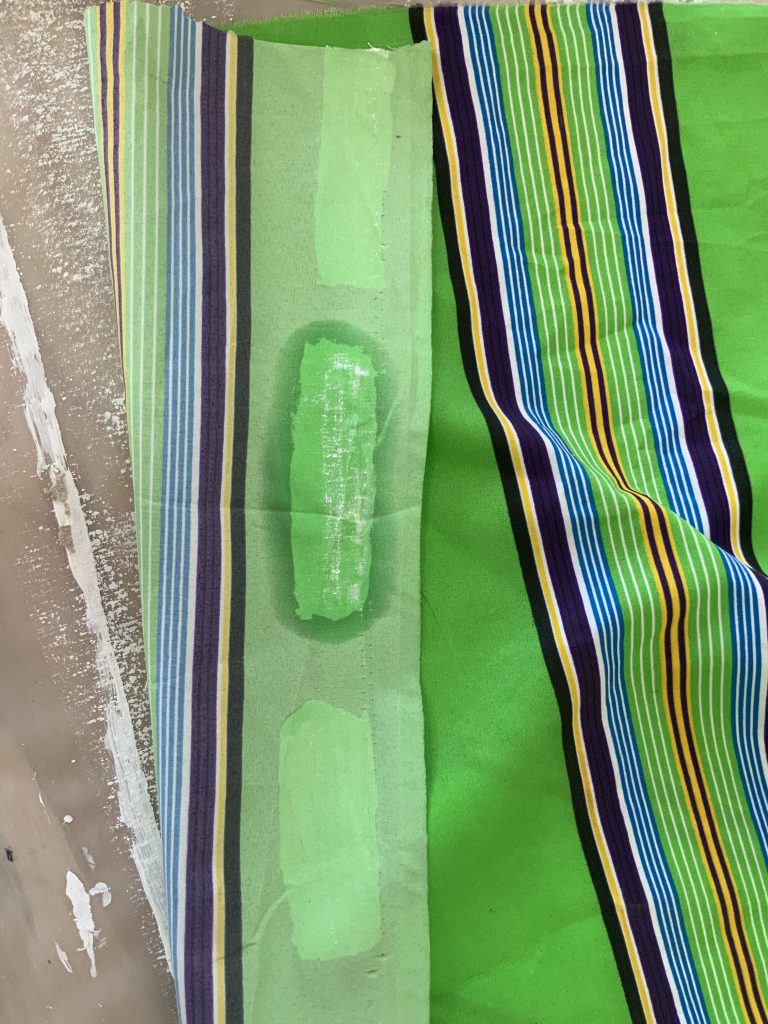
This morning on Instagram I read the view of an artist who is currently exhibiting in Dubai: “….we moved to an era of remaking, rethinking, redoing and reevaluating” (Hassan Sharif, 2/12/2021) See image as fig. The following idea to collage onto the painted (pre printed) fabric came to mind as an idea of remaking, rethinking, redoing, and reevaluating.
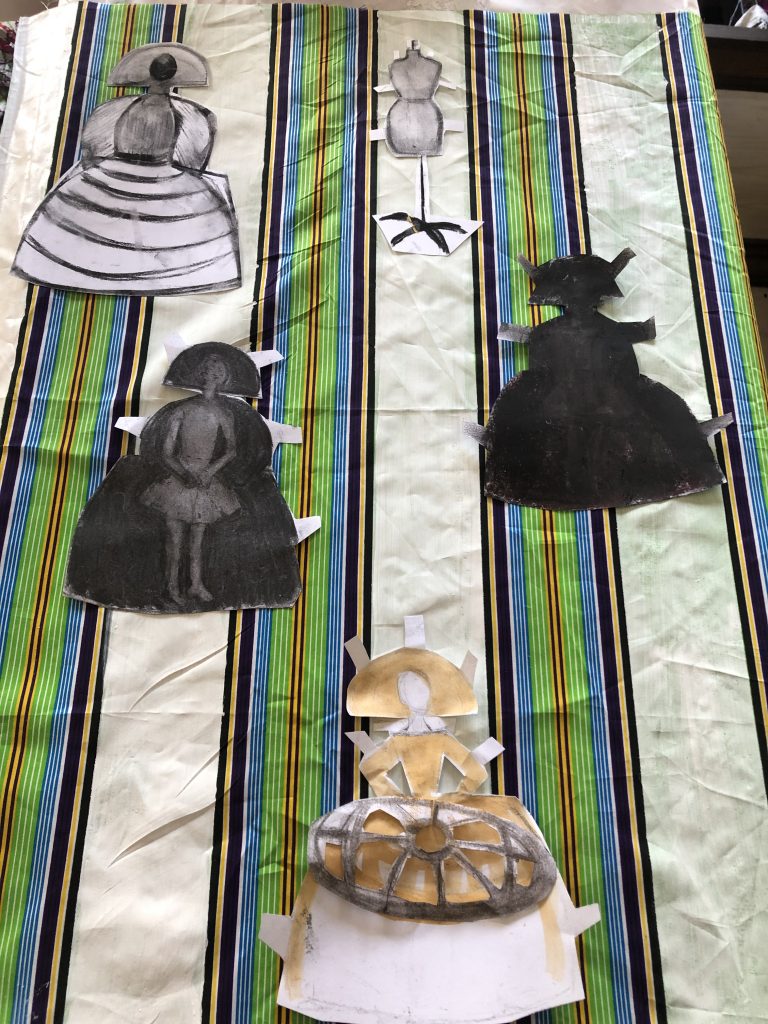
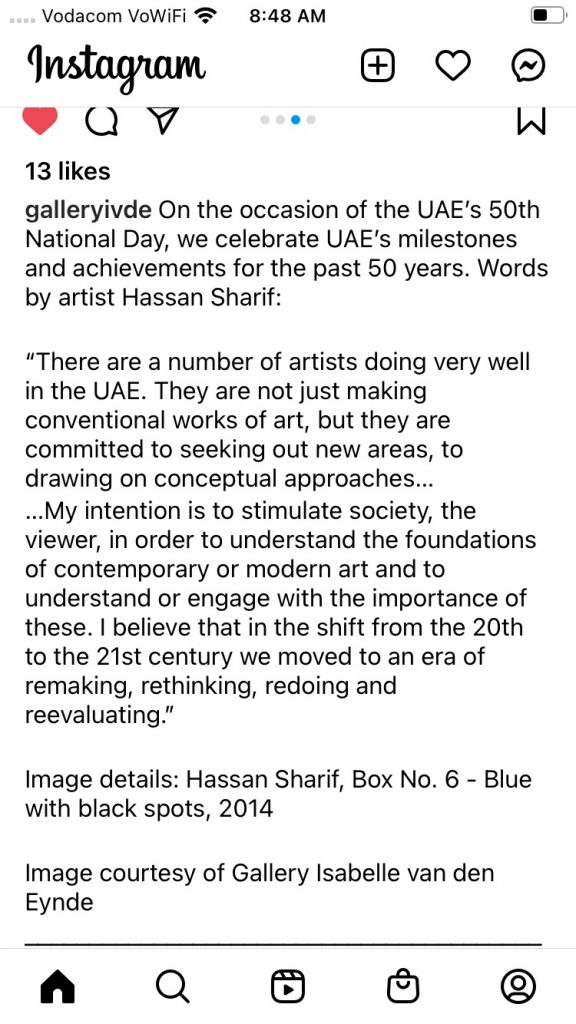
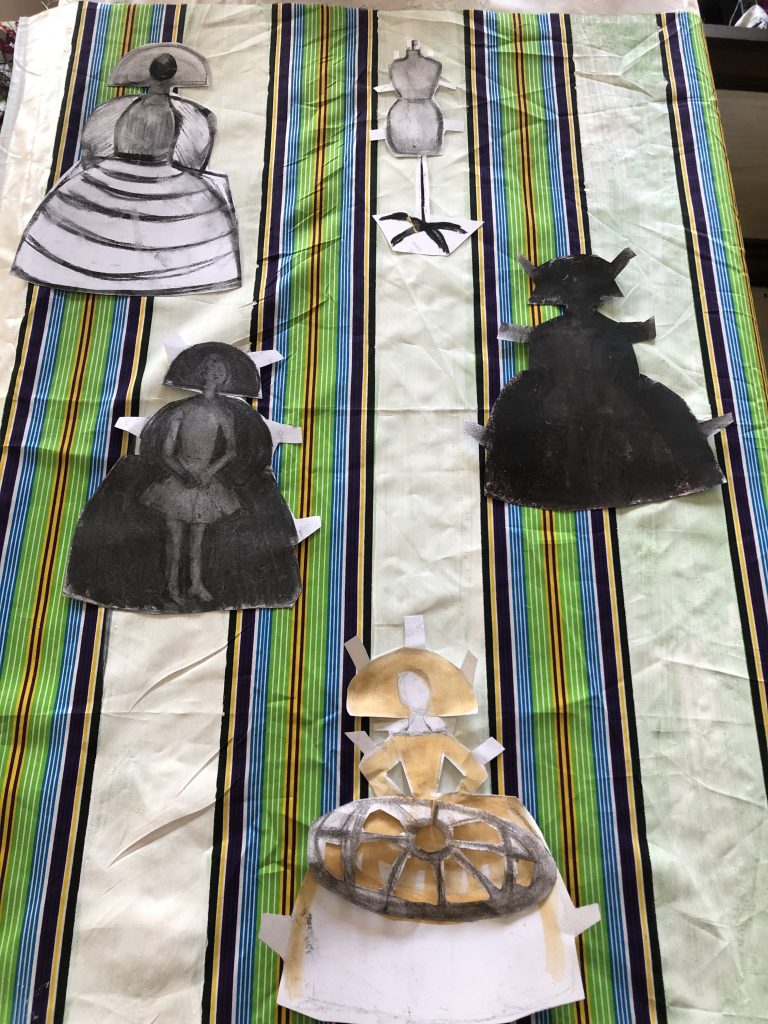
Daniel Buren worked with wallpaper as well. I want to consider paper versus canvas as support material. I have sheets of canvas paper. I find it a convenient way to use when painting in oils during my studies. Below is work on Seagrass done on plain paper, using acrylic inks, paint, and varnish. The paper is almost stiff in areas. It also shows how the materials seeped into the paper when turned around, and when rolled up and folded it becomes a small landscape, reminding me of the work of a student shown in the study material (p79)
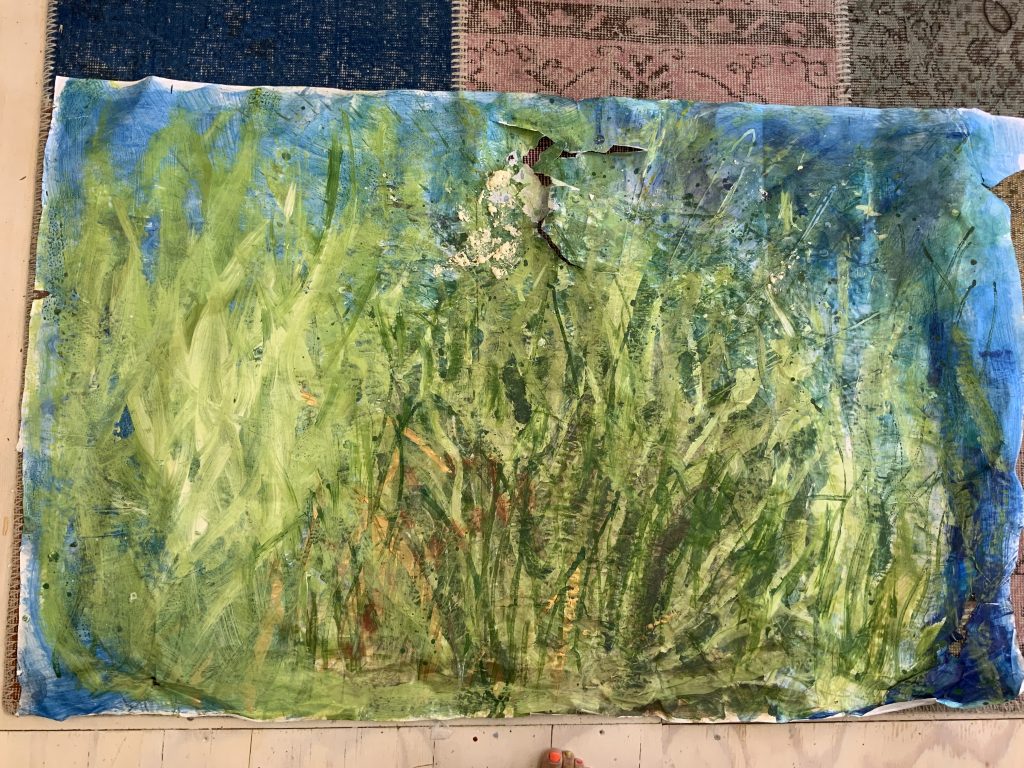
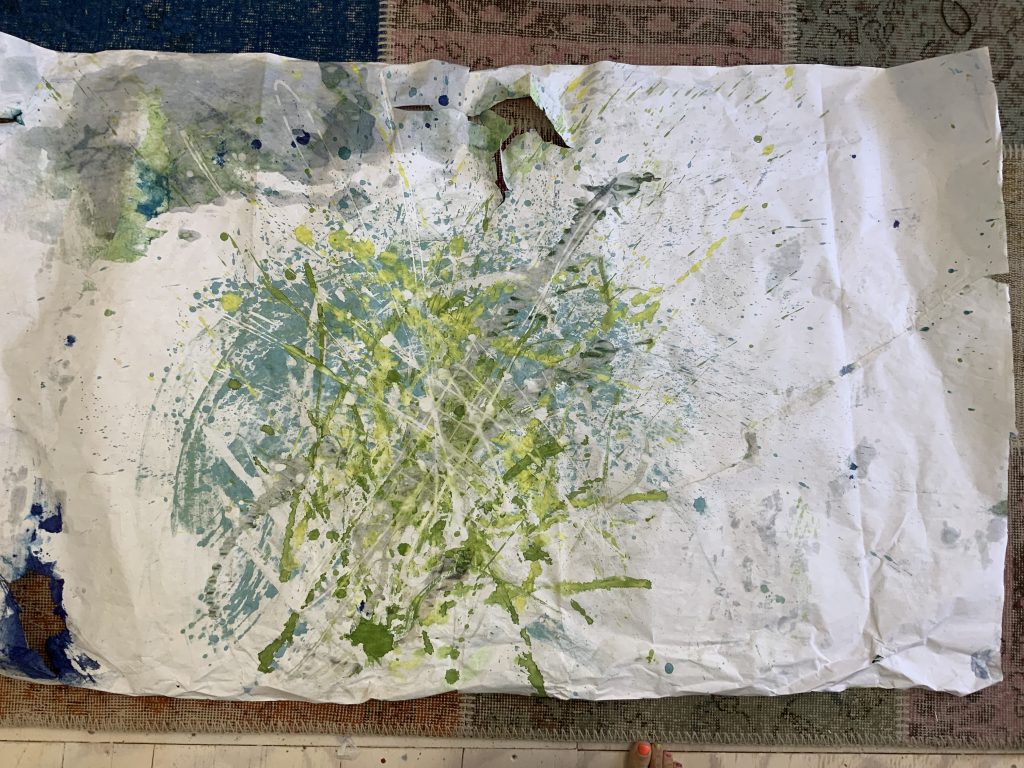
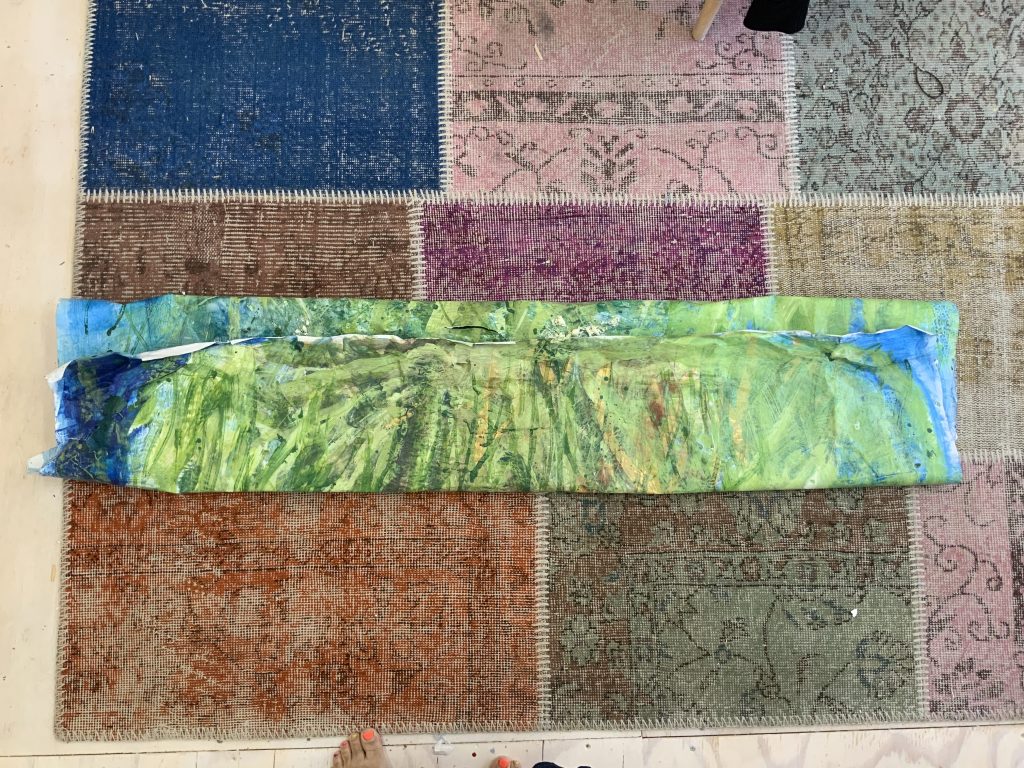
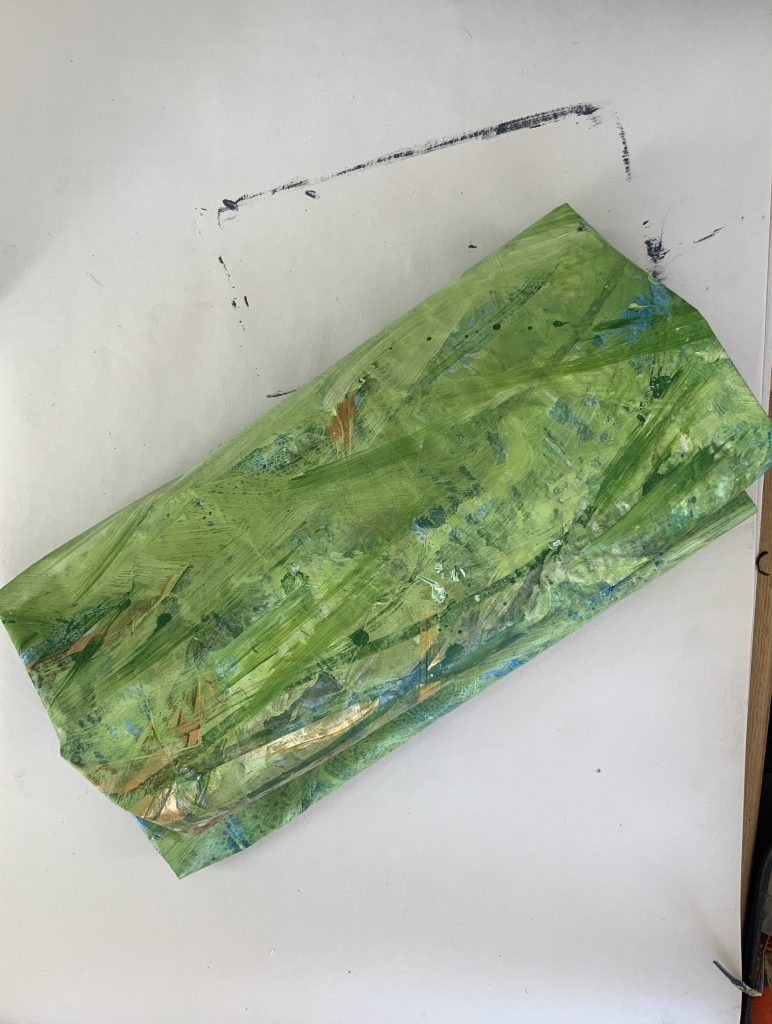
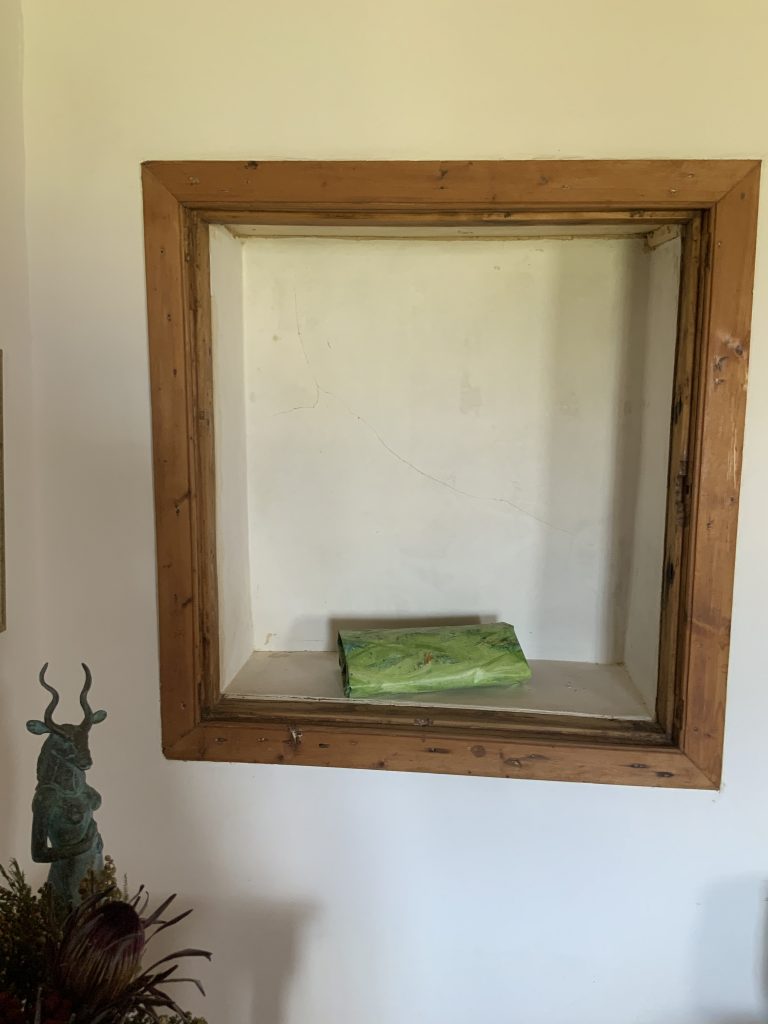
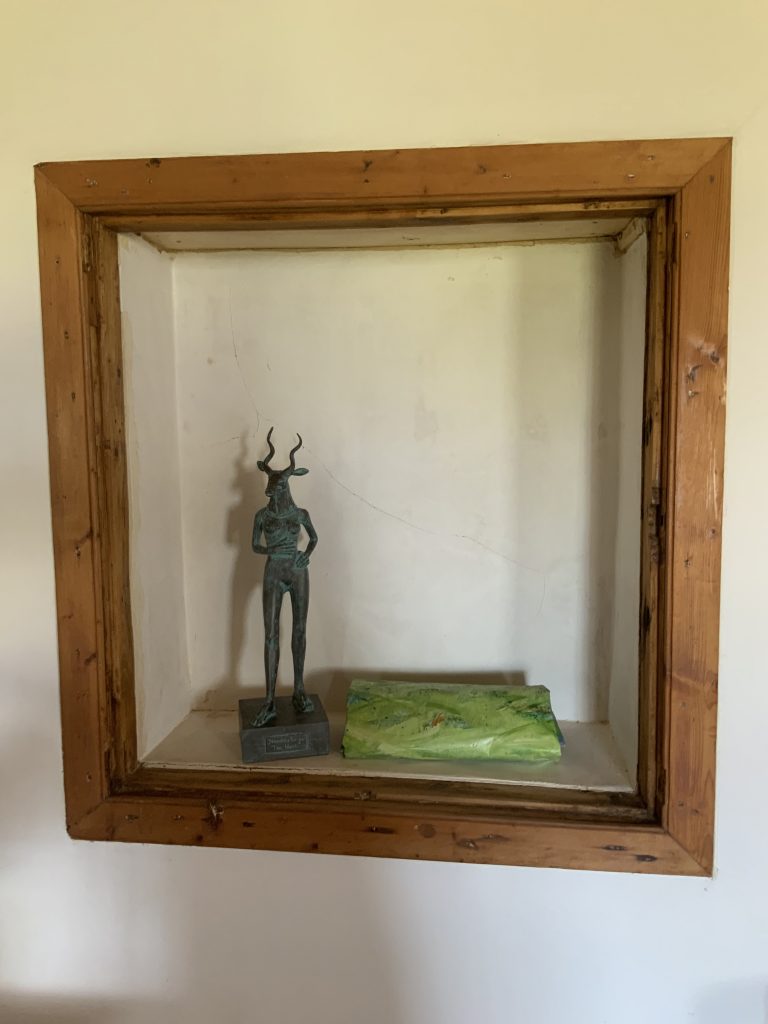
I have a collection of stamps that belonged to my father-in-law. It was never properly organized or valuated; just a bag of stamps and postcards. I do like exploring the stripe theme I found on the ‘airmail’ envelopes here. Looks like a lot of the stamps were collected from official communications during his work as a marine scientist at a government institution. He traveled a lot for conferences and presentations. Stamps that caught my mind are our own country ones – older ones which depict a lot about the history of Apartheid South Africa, as well as that of South West Africa, as Namibia was called before its independence. It could become a canvas filled with memory, I see on the envelopes a history of his career development, as a young researcher he eventually by the time he retired, moved up the ranks and became the Director of the Sea Fisheries Institute, reporting directly to the Minister with that portfolio. He used letters as communication, no emails! I can layer the stamps in plastic sleeves and then attach it as a bigger canvas – explore a collage-cum-archival collection? My father-in-law passed away during and we have photos and other work/travel/personal related items I could build into this work. After a workshop with a tutor, Hayley Lock, Peepshow, I would like to work on a box that can contain these items/objects – a curated work of art into the relation of the memories of my late father-in-law. I have looked at the work of Andy Warhol and M Duchamp as inspiration.
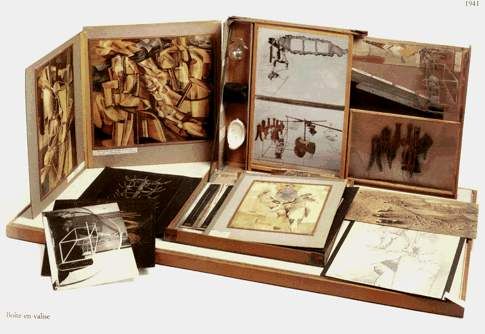
I think it is also an effective way to challenge the value of the material/canvas I use. Questioning if these stamps are of any value, why were they never archived? Will I lower the value of the stamps by making art? The stamps become the object. Is my art of any value? These questions all pertain to financial value – I am learning and exploring my own art-making process. I am not sure that the end product is of any value, the importance is the learning and developing of a work process of reimaging the canvas. By developing this work, I could abandon paint and a stretcher altogether.
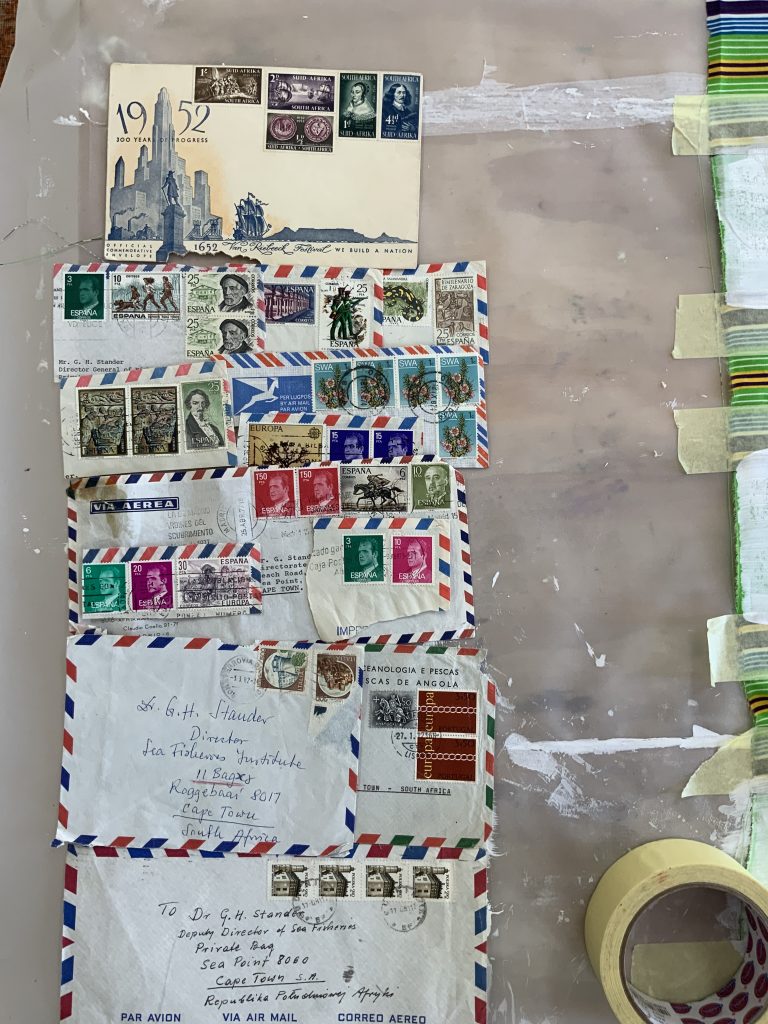
I tried a natural fiber floor rug – the idea was to make imprints of paint, using cork. The textures did not stick well to the acrylic paint and I made more attempts with a paintbrush. I decided to look at chalk-based paint, which is used for crafts like furniture and fabric painting. In fact, it is possible to make your own chalk paint by adding some Plaster of Paris or baking soda to your regular latex paint or Acrylic paint, although the result isn’t as flawless as you’ll get from commercially produced Chalk Paint. The last two white dots were made with acrylic paint mixed with plaster of Paris powder. It is clearly a better option to colour the grass before weaving, but I tried to paint on a textured surface and did not make a good painting. More attempts and different skills, like working with a stencil, could possibly bring an aesthetically pleasing result.
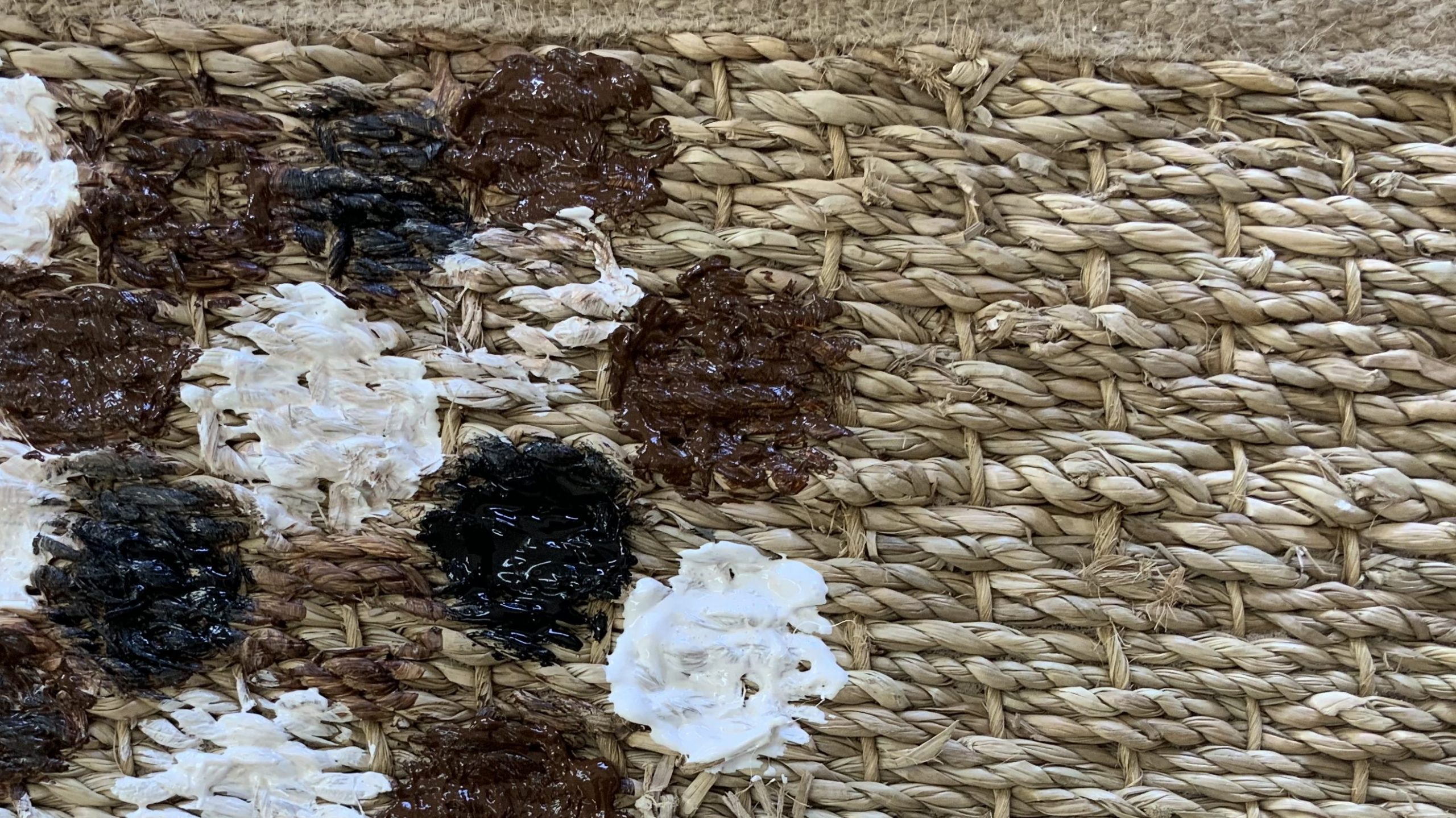
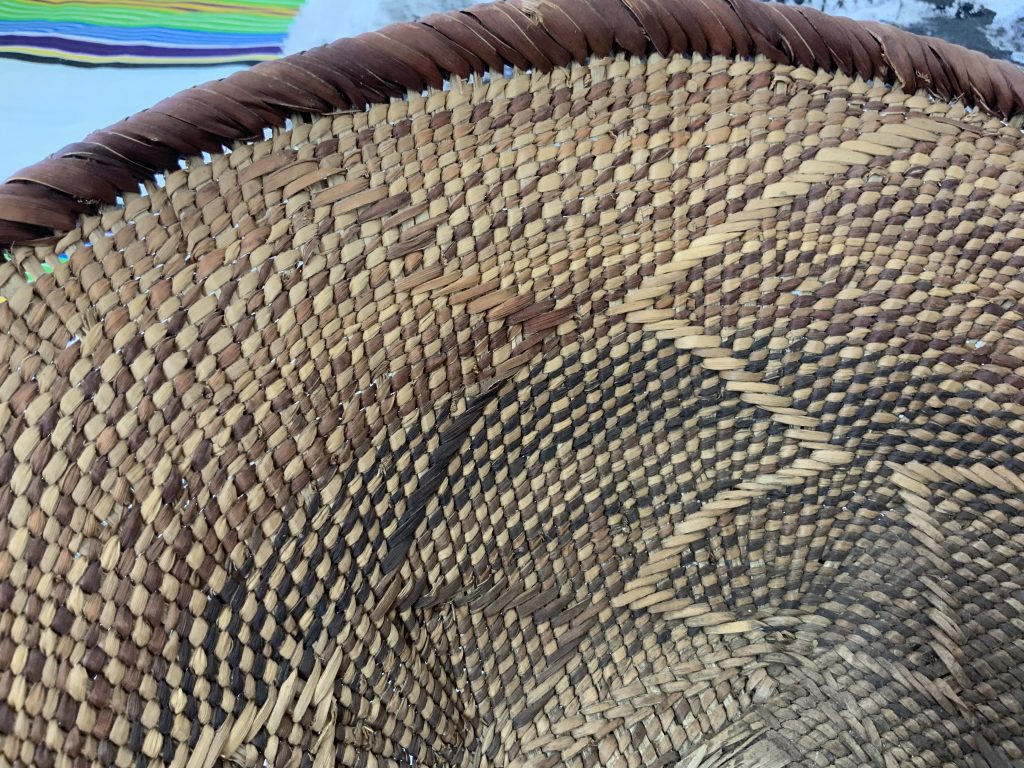
Below are two rocks I collected whilst walking. The markings were made over time and are revealed by the surface.
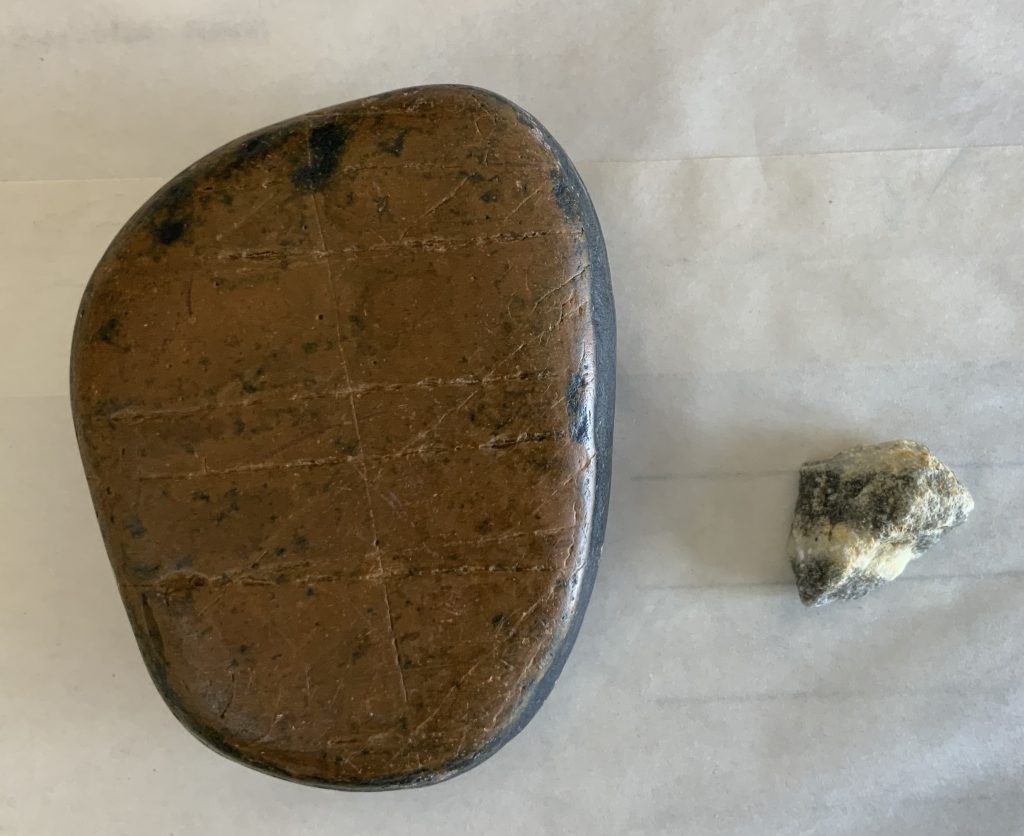
I came upon collaboration work between R Rauschenberg and his ex-wife , the artist, Susan Weil on the Artforum website.
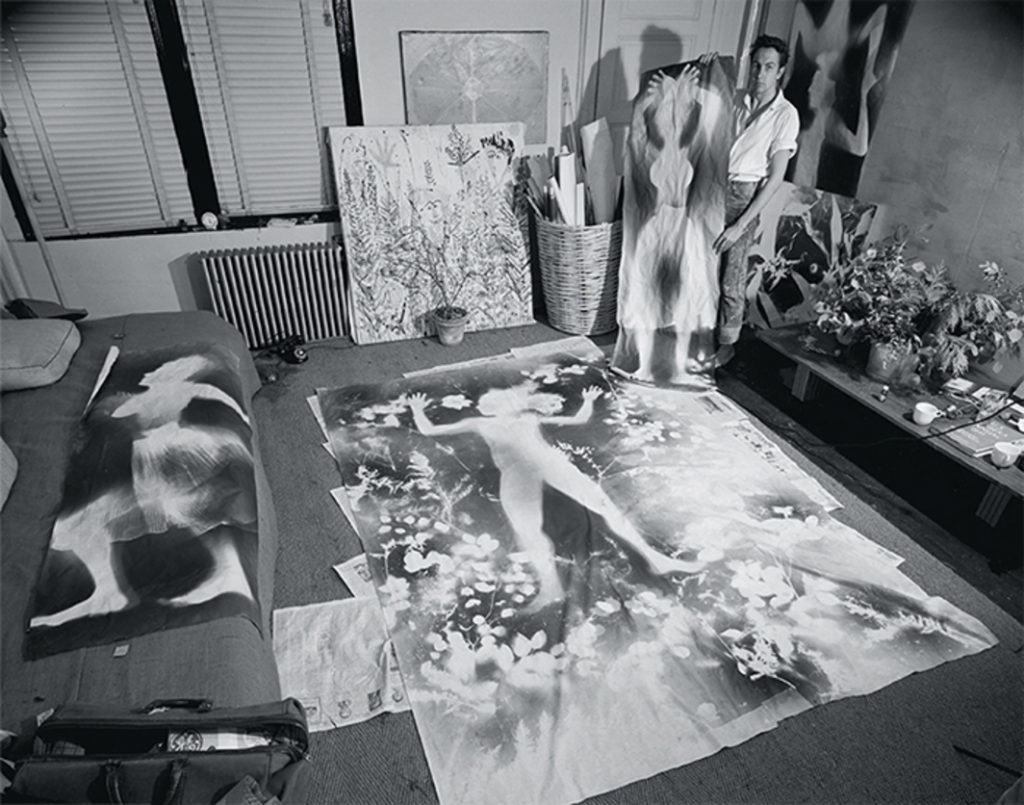
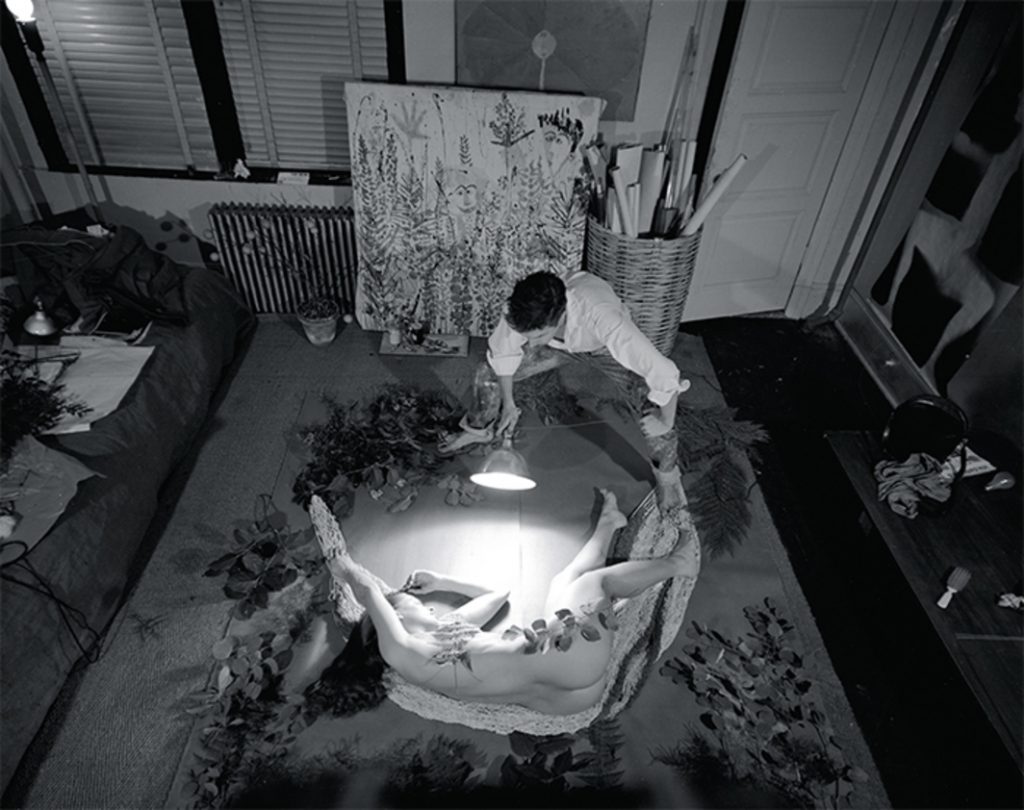
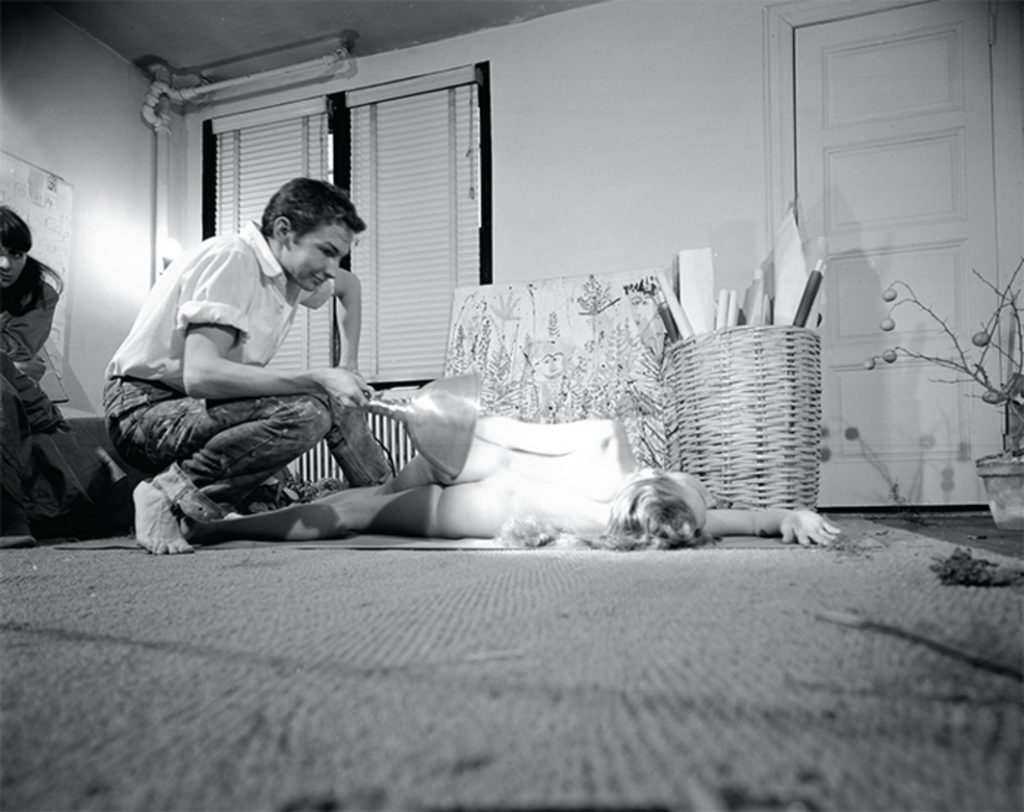
This made me look at the work of S Weil, which I saw as critique of the structures of the canvas and painting. I read that this artist fractures or breaks the picture plane in her work, she deconstructs and reconstructs images (flat 2 dimensional) using a range of materials including collage, blueprint, and paint on recycled canvas, acrylic and wood. (the video below shows here work as she talks in there as well) She describes some of her creative ideas as, “swapping, trading, crumpling”. From her work a understanding comes from how a viewer is almost forced to think about perspective of reality and space, she also shows the viewer movement in time with many of her works, and all on a flat 2-dimensional plane, mostly hanging on the wall. I like how she changes scale and show the viewer her own perspective.
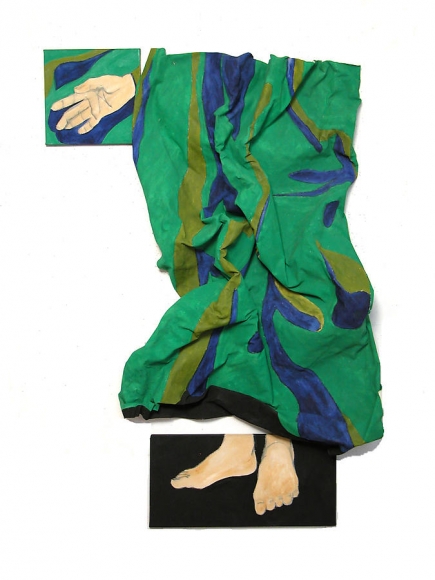
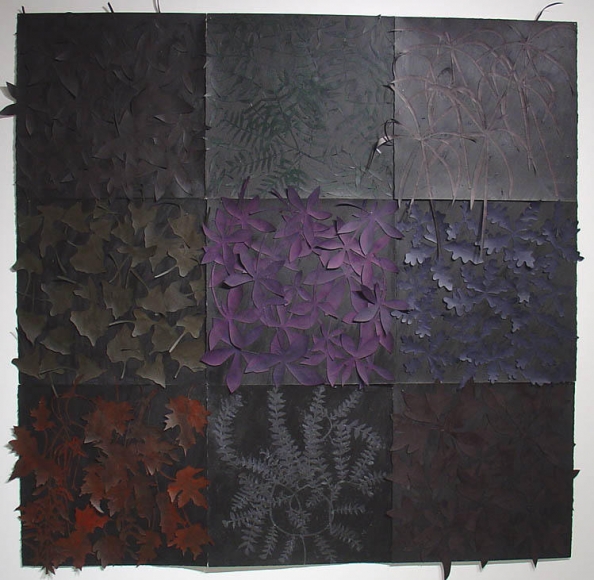
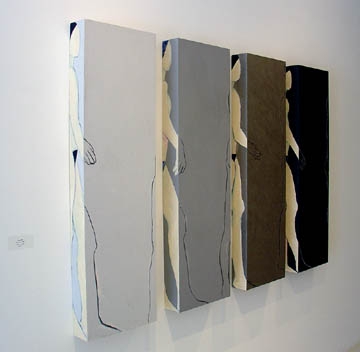
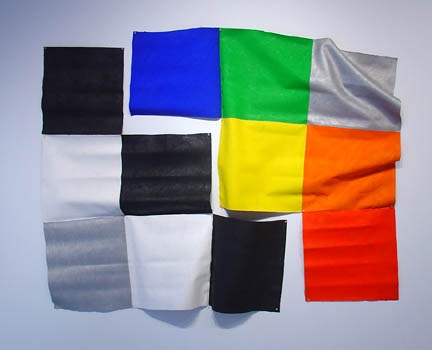
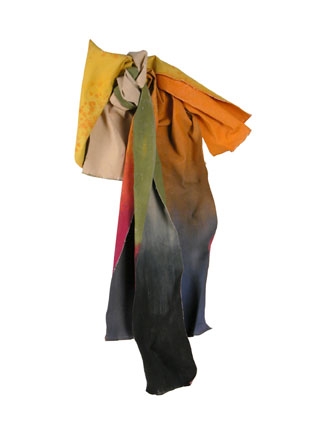
REFLECTION
I feel a lot of questions followed whilst working on different ‘canvas’ surfaces. It asked me to consider the idea of ‘plane’ and therefore I considered both a three-dimensional surface and a two-dimensional surface. I also think the surface became a place/ location where things interact with each other and if the question is about how the surface invites or influences me when I stand in front of it? I am not sure if I was supposed to interrogate the surface. In the image below I ‘framed’ the canvas and added collage. It shows the interaction or relationship between materials and medium I think I worked with. It was in a way also a way to look at the canvas, discover it as an object and material onto or with which I could explore drawing, painting, making 3d work, as well as perform with or on.
I think my learning from my own making and explorations with different canvases made me come to an understanding that this project had a lot to do with the need for a painting to be physically and socially presented in an environment that the artist ( I) have ‘control’ over in terms of making decisions on what to do and where to show. The process, when I started making the folded canvases and painting onto them, brought me to realize that I do not have control over the outcome, the canvas did not allow that.
I read that in 1972, Leo Steinberg described a major shift in painting that he identified, at the time, as “post-Modernist.” The picture plane being treated as a flatbed, similar to tabletops, studio floors, charts, bulletin boards— what he stated was it could be any receptor surface on which objects are scattered, or on which data is entered, or on which information may be received, printed, impressed.
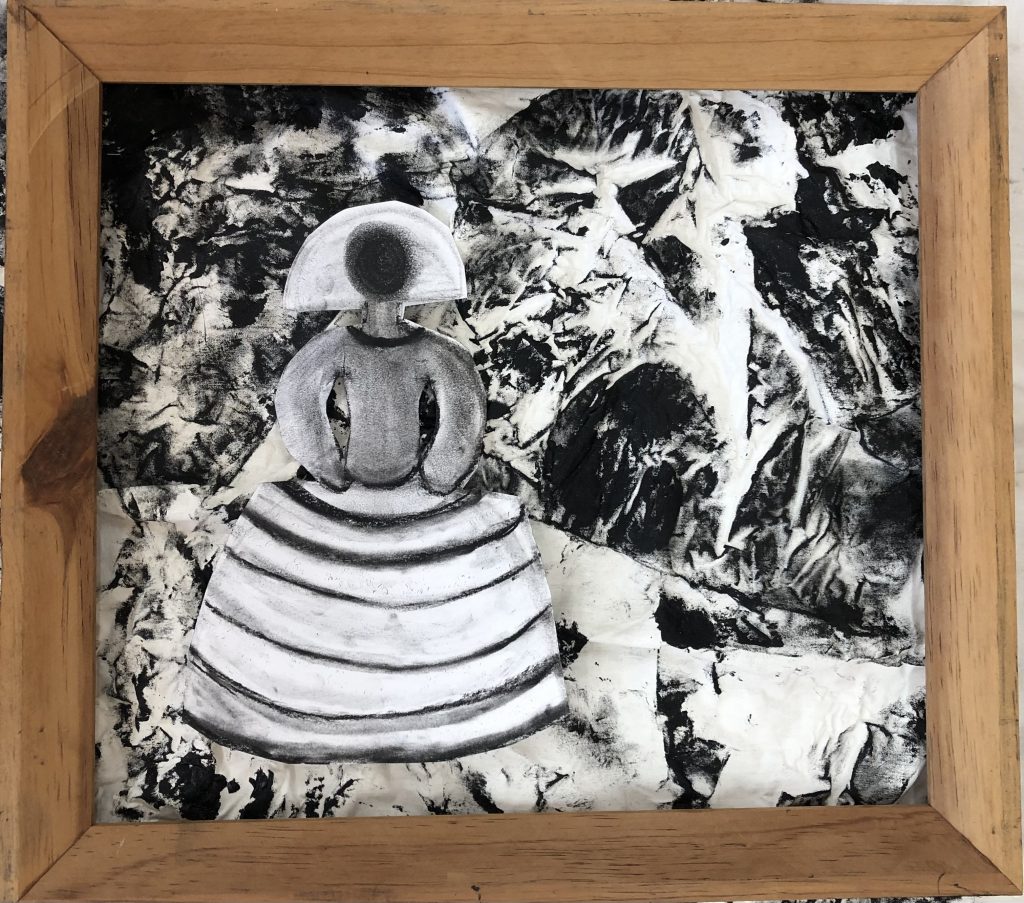
I do believe the different canvases as support made me consider my ideas for work with materials – looking at a piece of canvas/linen that is not attached to support brought me into contact with the texture of the material which made me think of objects or ideas and materials I could work with, which would go with the materiality. Folds and creases were the most interesting to work on as I think it also became an event and discovery. It can stay a process in development for 3d work as well.
List of Illustrations
Fig. 1 Stretching a canvas [advertisement] Pinterest image (Accessed 22/11/2021)
Fig. 2 Dugmore, H. (2021) Timeslive [photograph] At: https://www.timeslive.co.za/sunday-times/opinion-and-analysis/2021-05-02-in-pics–a-day-on-the-beach-100000-years-ago/ (Accessed on 20/11/2021)
Fig. 3 Dugmore, H. (2021) Timeslive [photograph] At: https://www.timeslive.co.za/sunday-times/opinion-and-analysis/2021-05-02-in-pics–a-day-on-the-beach-100000-years-ago/ (Accessed on 20/11/2021)
Fig. 4 Dezueze, D. (1960) Sliders, [exhibition Musee Fabre] At: https://museefabre-en.montpellier3m.fr/Exhibitions/Daniel_Dezeuze_sculptures (Accessed on 21/11/2021)
Fig. 5 Dezeuze,D. (1960) Tableaux-valises et Dessins [Painted suitcases] At : https://www.galleriesnow.net/shows/daniel-dezeuze-dessins/ (Accessed on 21/11/2021)
Fig. 6 Stander, Karen. (2021) Material explorations [Paint and aluminium support] In possession of: the author: Langvlei, Riebeeck West.
Fig. 7 Stander, Karen. (2021) Material explorations with supports [Paint and aluminium] In possession of: the author: Langvlei, Riebeeck West.
Fig. 8 Stander, Karen. (2021) Material explorations with aluminium as support [Painting] in possession of: the author: Langvlei, Riebeeck West.
Fig. 9 and Fig 10 Stander, Karen. (2021) Supports with Gypsum x 2 [wet stage and dry stage ] in possession of: the author: Langvlei, Riebeeck West.
Fig. 11 Stander, Karen.(2021) Support exploration [teabags] In possession of the author: Langvlei, Riebeeck West.
Fig. 12 Stander, Karen. (2021) Studio cloth [cotton fabric] In possession of the author: Langvlei, Riebeeck West.
Fig. 13 Stander, Karen. (2021) Organic object [expansion foam in cloth] In possession of the author: Langvlei, Riebeeck West.
Fig. 14 Hodges, Jim. (2009) The Place 1 [Charcoal and saliva on paper] At: https://www.artsy.net/artwork/jim-hodges-the-place-number-1-slash-from-the-way-between-places (Accessed on 22/11/2021)
Fig. 15 Hodges, Jim, (2016) I dreamed a world [glass on canvas] At: https://www.vice.com/en/article/9anxy8/cut-up-mirrors-get-rearranged-into-magnificent-glass-room (Accessed on 21/11/2021)
Fig. 16 -20 Stander, Karen. (2021) Deconstructing a canvas [paint on canvas] In possession of the author: Langvlei, Riebeeck West.
Fig. 21 and Fig 22 Hantai, Simon (1968) Artist at work [folded canvas and paint] At: https://dianedepolignac.com/home-fr/les-newsletters/newsletter-lart-vient-a-vous-n-13-roswitha-doerig-sortir-du-cadre/simon-hantai-baches-meuns-1968-works/ (Accessed on 23/11/2021)
Fig. 23 – Fig 28 Stander, Karen. (2021) Preparing and folding the canvas [cotton and paper] In possession of the author: Langvlei, Riebeeck West.
Fig. 29 Stander, Karen. (2021) Folded canvas with paint on folds [cotton and enamel paint] In possession of the author: Epsom.
Fig. 30 Buren, D. (1966 – ) Mur de Peintures [canvas and acrylic paint] Online viewed at: https://karenstanderart.com/wp-content/uploads/2021/11/Buren-Stripes-at-Guggenheim-1024×682.jpeg (Accessed on 01/12/2021)
Fig. 31 Stander, K. (2021) Wool and Textiles under investigation [Canvas, wool and fabric] In possession of: the author: Langvlei, Riebeeck West.
Fig. 32 Hicks, Sheil. (2019) Online viewed at: https://www.artsy.net/article/artsy-editorial-women-weavers-bauhaus-inspired-generations-textile-artists (Accessed on 03/12/2021)
Fig. 33 Weil, Susan (1988 – 2004) Selected works as images in my blog [Textiles, acrylic, wood] Online viewed at: https://www.sundaramtagore.com/exhibitions/susan-weil2/selected-works?view=slider (Accessed on 05/12/2021)
Fig. 34 Stander, Karen (2021) Collage with Last Meninas [paper and fabric exploration] In possession of: the author: Langvlei, Riebeeck West.
Bibliography
Art Forum, (1972) Reflections on the state of Criticism. At : https://www.artforum.com/print/197203/reflections-on-the-state-of-criticism-37502 (Accessed on 10/12/2021)
Chuimer-Layen, Virginie. (2021) Daniel Dezeuze, the eternal question of the painting La Gazette Drouot article onlineencyclopedia.com. Article on Striped Cloth https://www.encyclopedia.com/fashion/encyclopedias-almanacs-transcripts-and-maps/striped-cloth
Gallery Isabelle van den Eynde, 2021 Hassan Sharif Instagram post on 2 December 2021
Lyotard Jean Francois (1981) The Works and Writings of Daniel Buren: An introduction to the philosophy of contemporary art pdf article At: https://www.artforum.com/print/198102/the-works-and-writings-of-daniel-buren-an-introduction-to-the-philosophy-of-contemporary-art-35735 (Accessed online on 23/11/21)
Kerlidou G , (2014) A Supports/Surfaces Moment: Contradictions, Paradoxes and other Ironies. At: https://hyperallergic.com/144790/a-supportssurfaces-moment-contradictions-paradoxes-and-other-ironies/. (Accessed online on 23 Nov 2021)
Lobel, Michael, 2016. Lost and Found: Susan Weil and Robert Rauschenberg’s Blueprints. Artforum print 2016. https://www.artforum.com/print/201602/lost-and-found-susan-weil-and-robert-rauschenberg-s-blueprints-57461 ( Accessed online on 29 November 2021)
McDermontt, Emily, 2015 Stripes across the decades, Interview with Daniel Buren
Mashinge, Mashudu and Raphalalani Matodzi R. 2018. Tshivenda Female Attire: A Socio-cultural Significance, Southern African Journal for Folklore Studies 28 (2):14. December 2018 (Accessed on 1 December 2021)
Simonhantai.org Hantai Simon https://simonhantai.org/en/oeuvres/periode/16/later-works
Stander, K (2021) Performance video of making of folded canvas [I pad video] In possession of: the author: Langvlei, Riebeeck West.
Reisinger, Barbara , 2017. Nothing but stripes? Historicizing Daniel Buren’s printed papers Paper for: Printed Media: Conceptualism and DisseminationPanel at IAWIS International Conference, Lausanne (Switzerland) July 10-14, 2017
Van Dyke,RM (ed.) 2015, Practicing Materiality, University of Arizona Press, Available from: ProQuest Ebook Central. (1 December 2021).
Viso, Olga, February 2014 Choreographing Experiences in Space: Olga Viso Interviews Jim Hodges. Online article with images https://walkerart.org/magazine/jim-hodges-olga-vis (Accessed on 30/11/2021)
Warnock, Molly Close up: manifold address